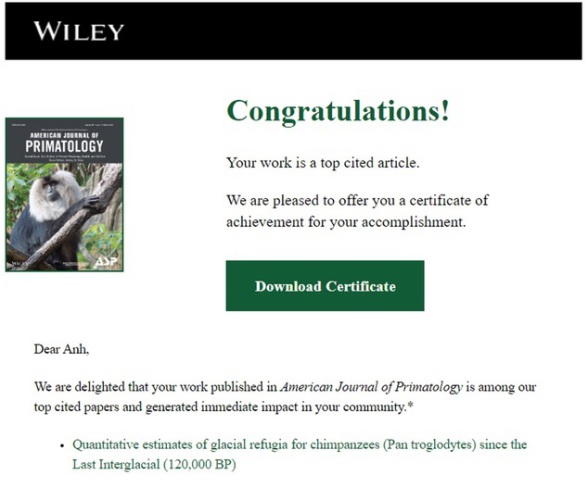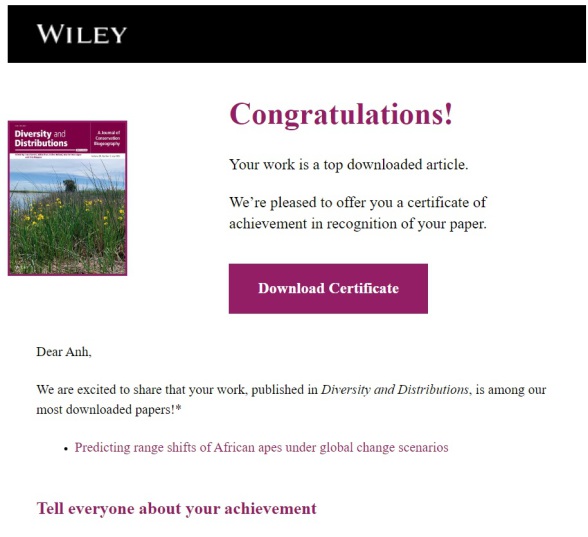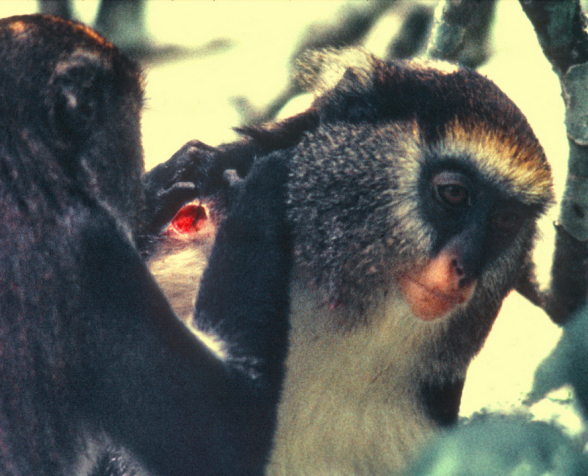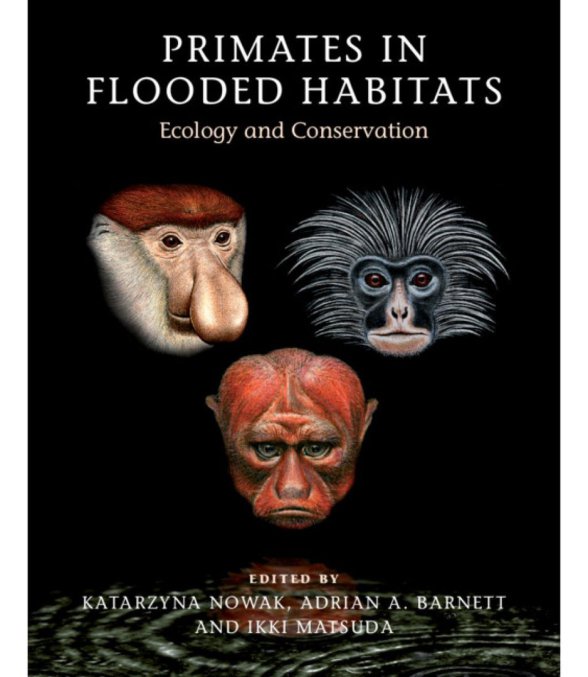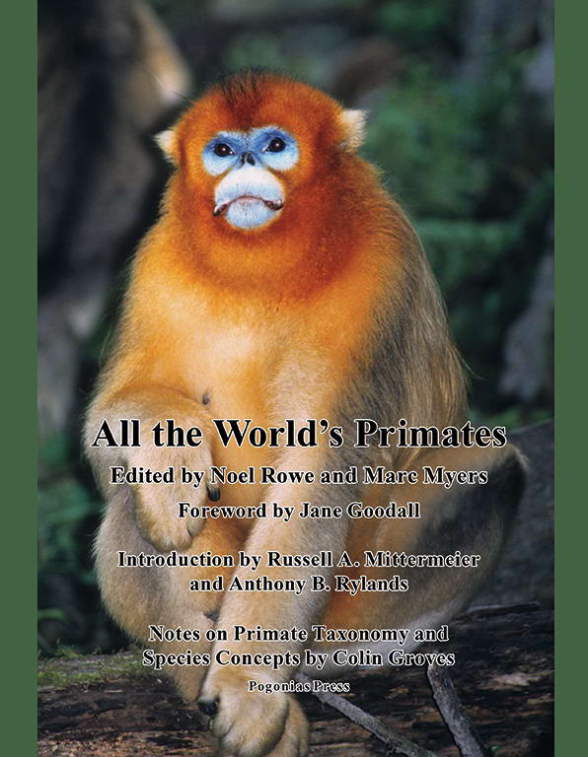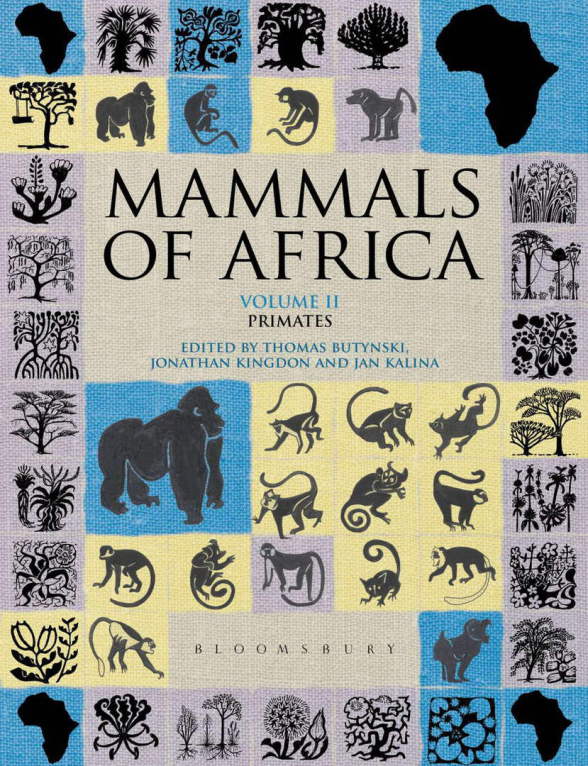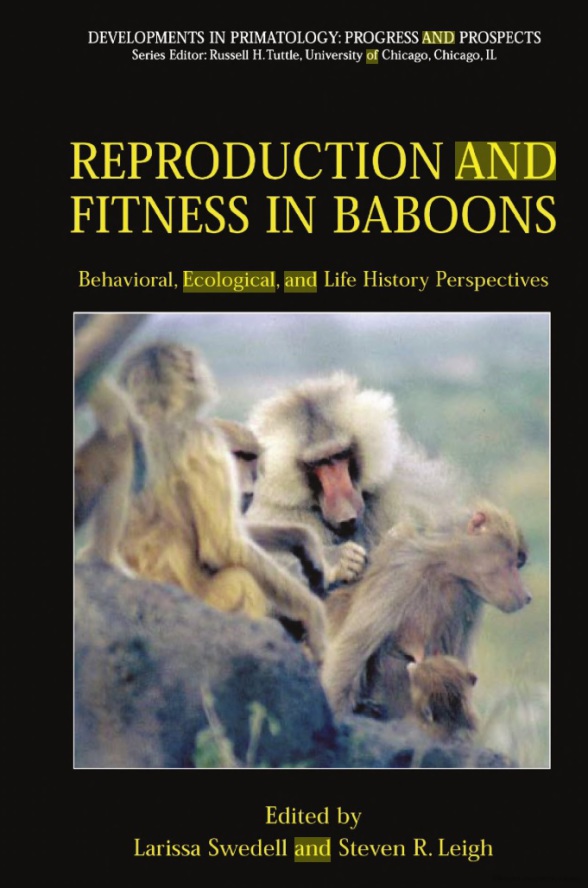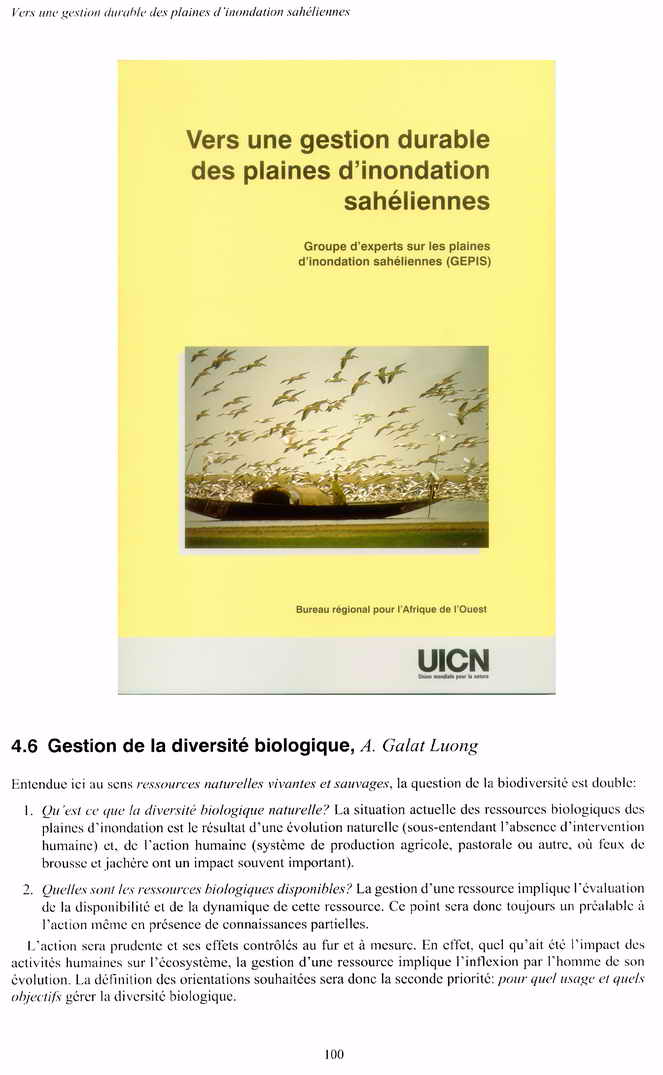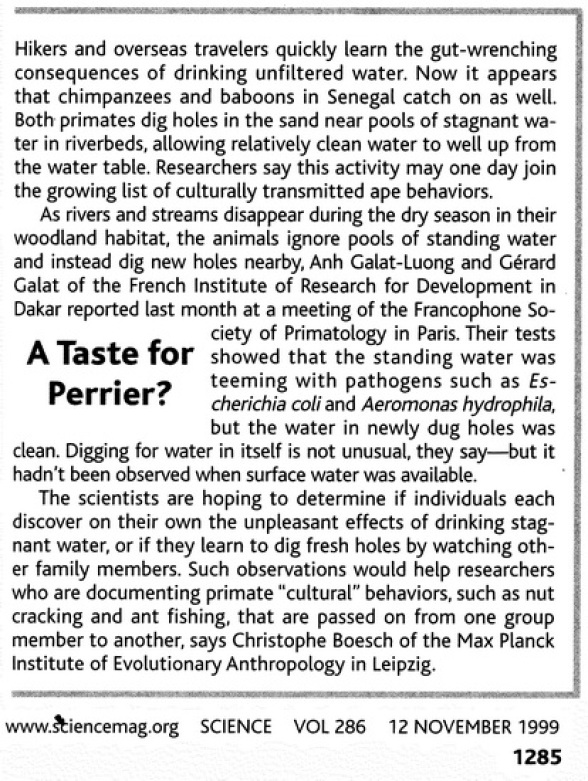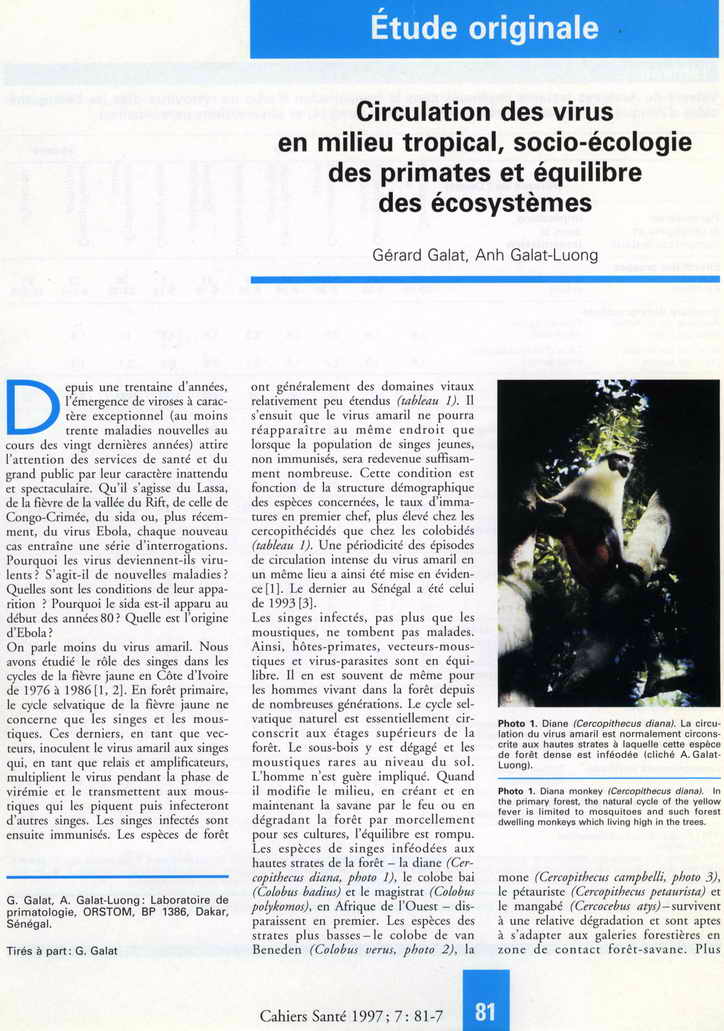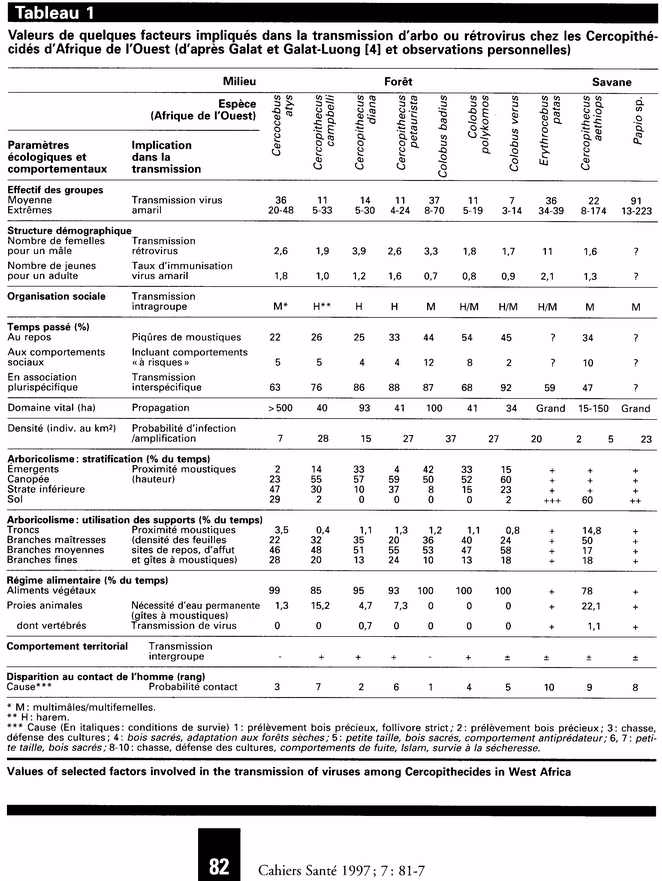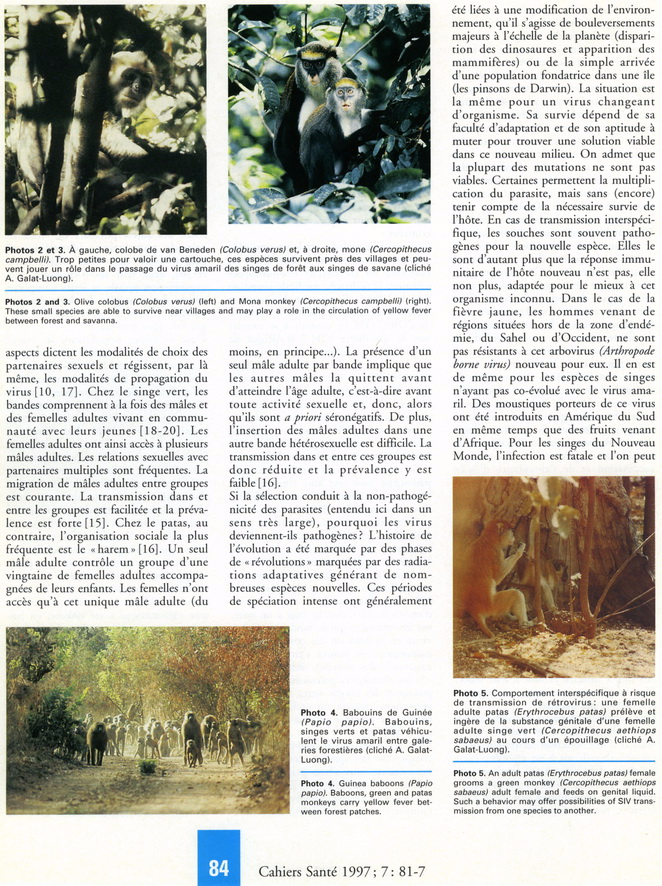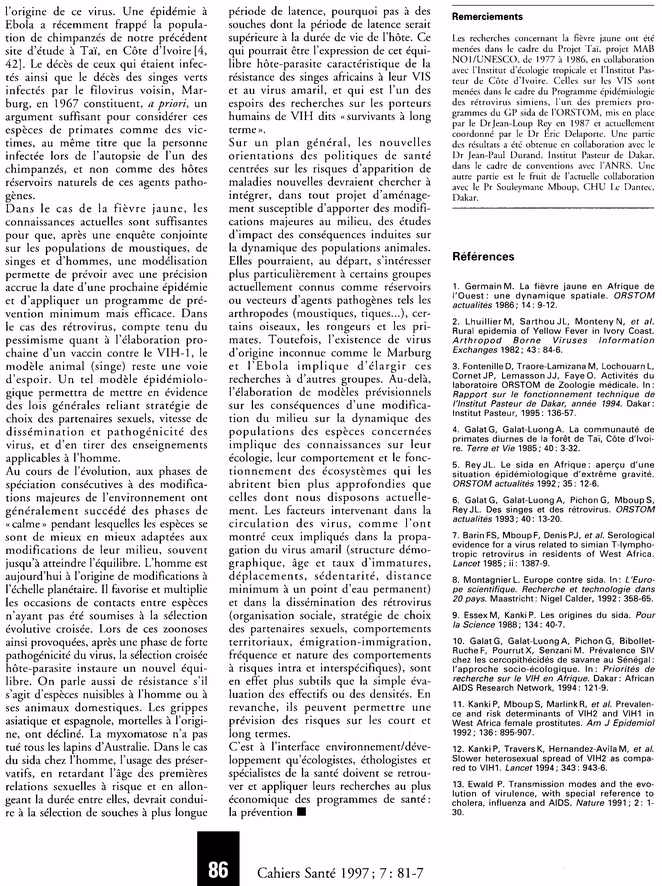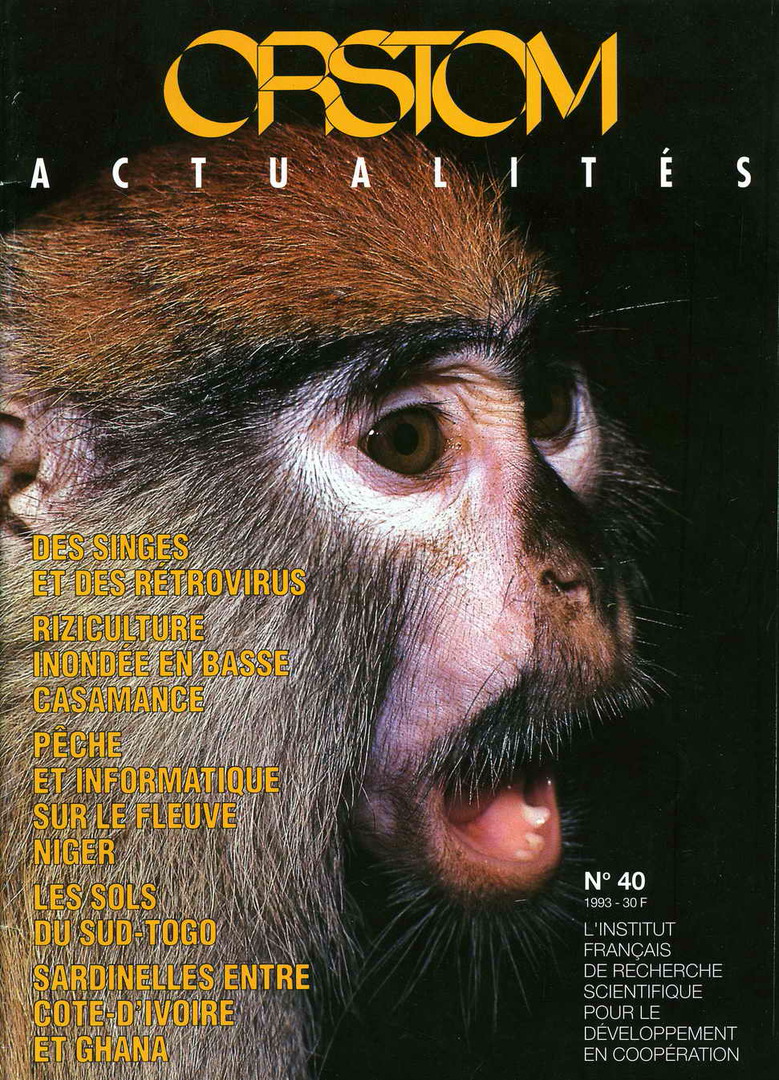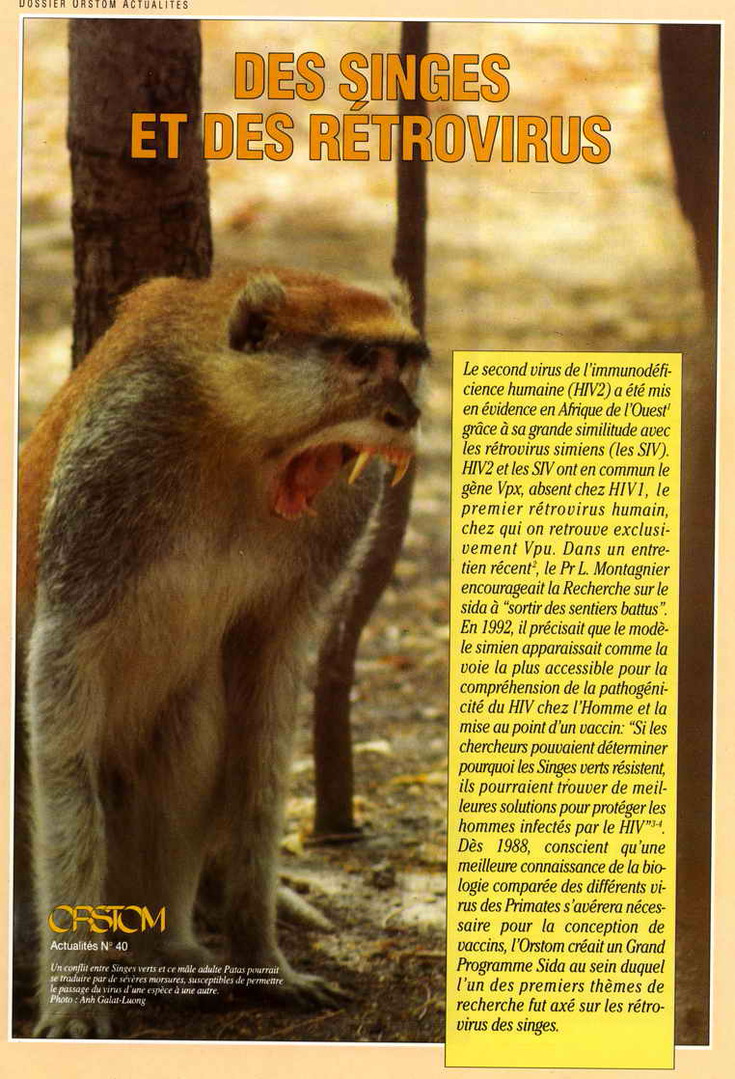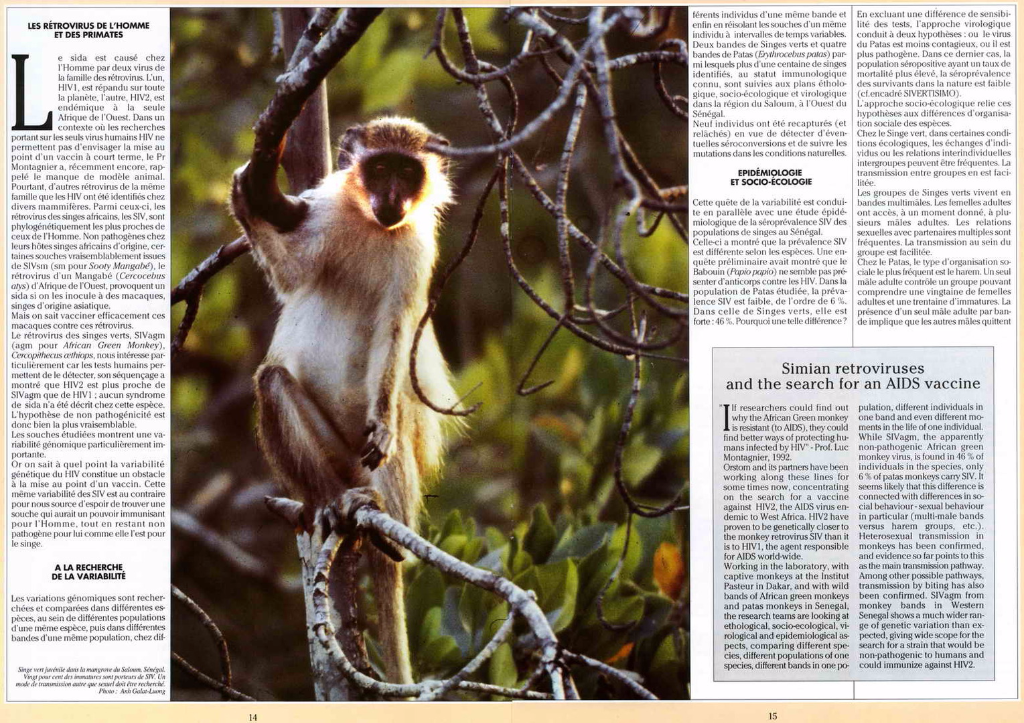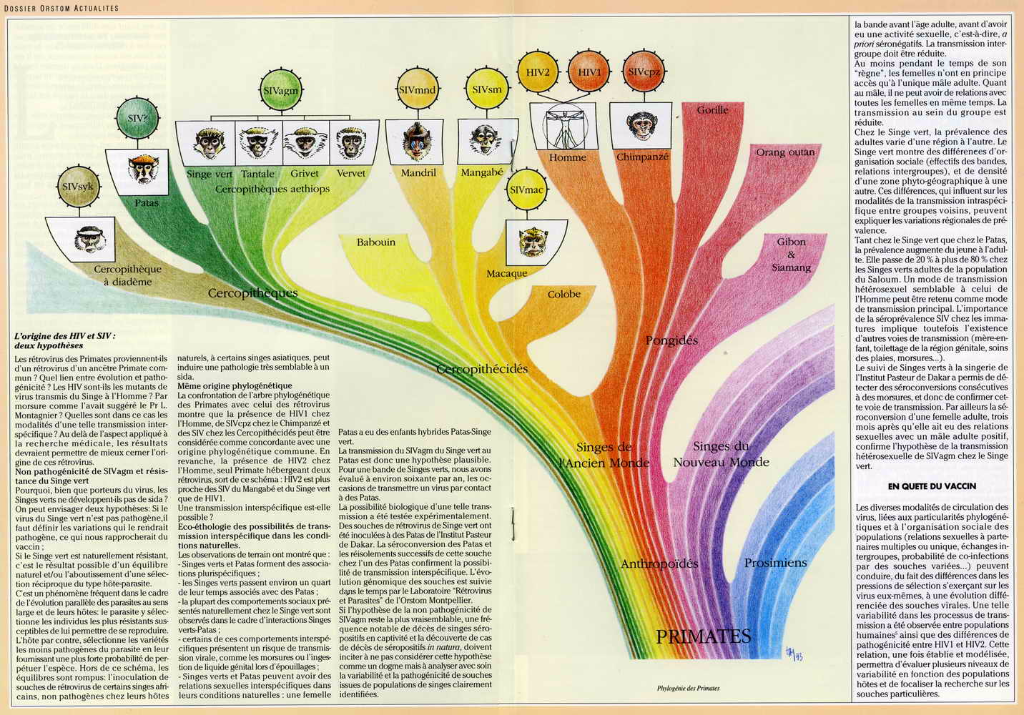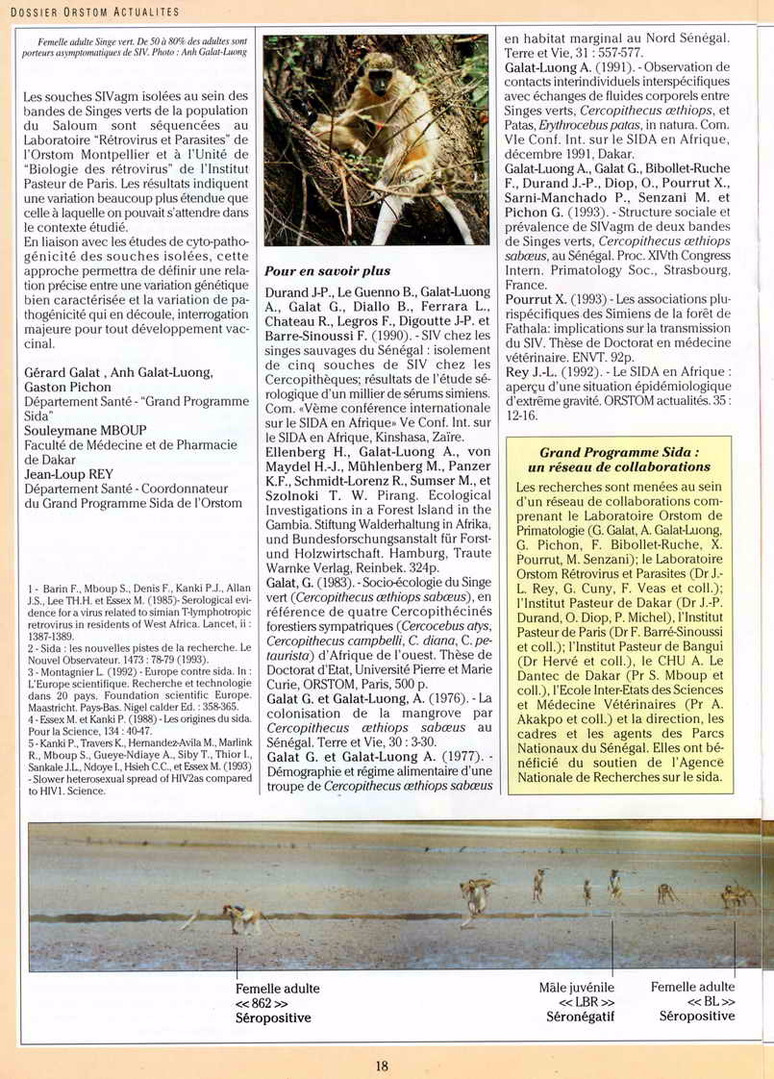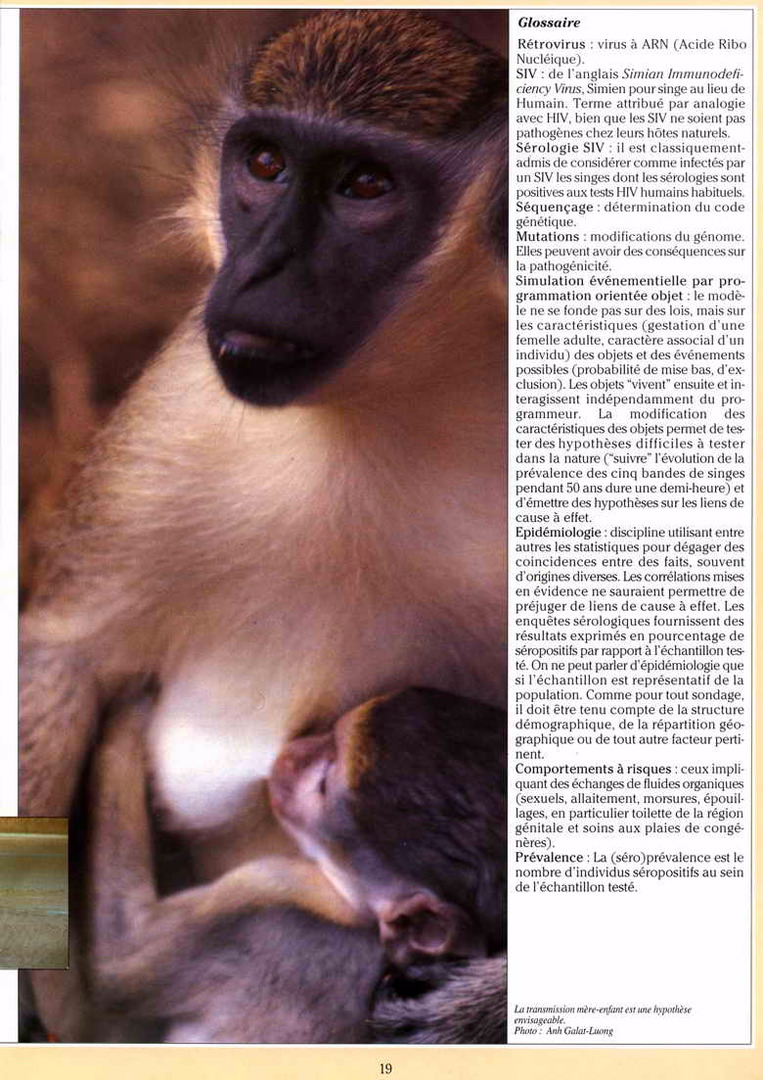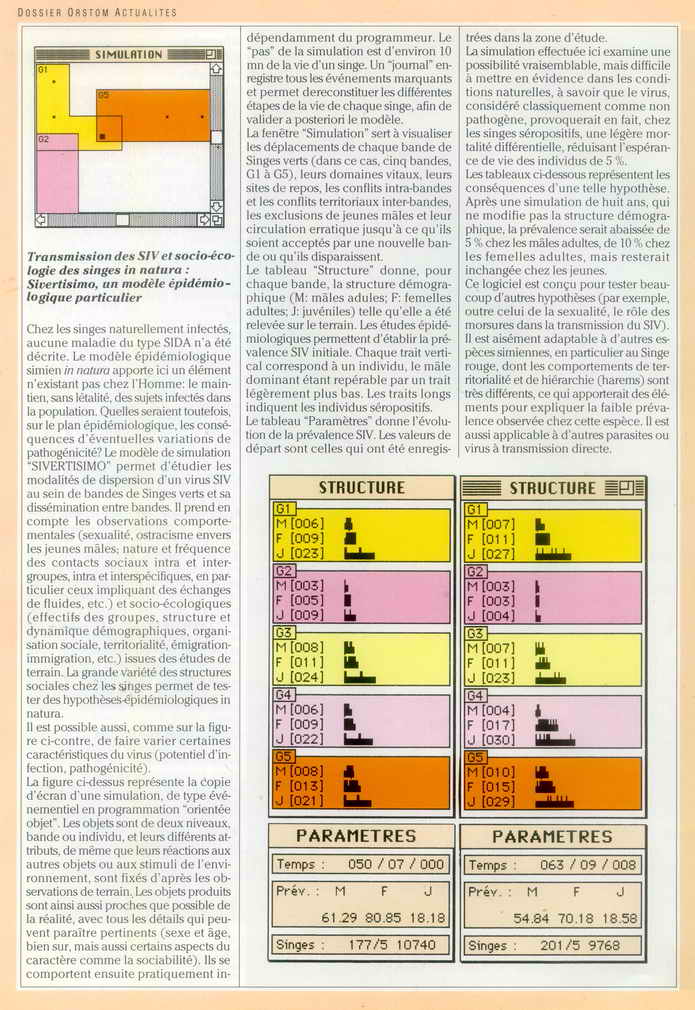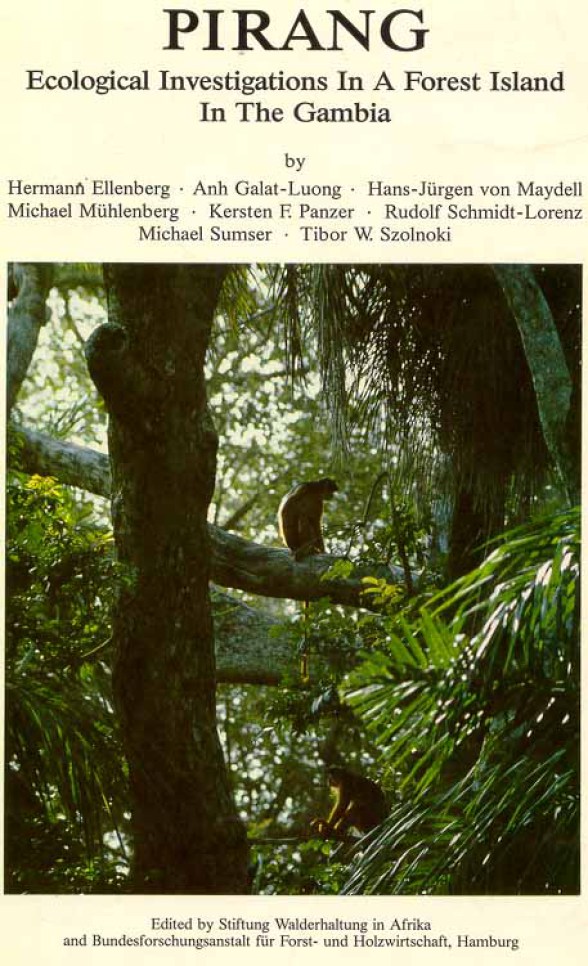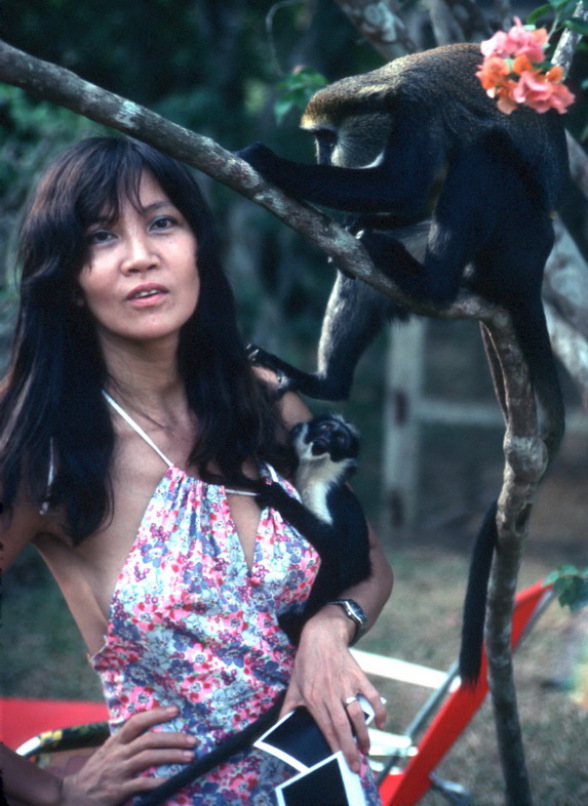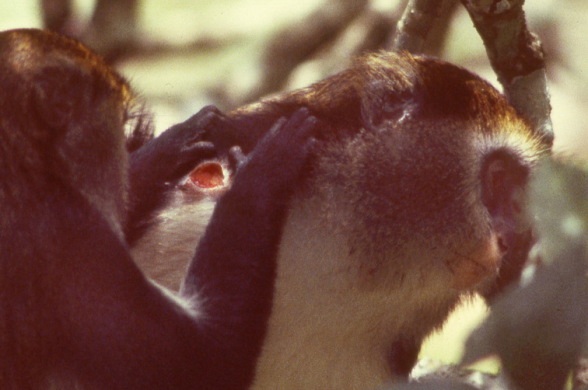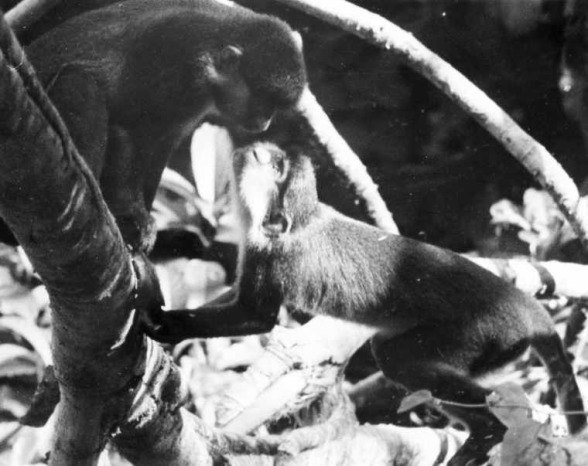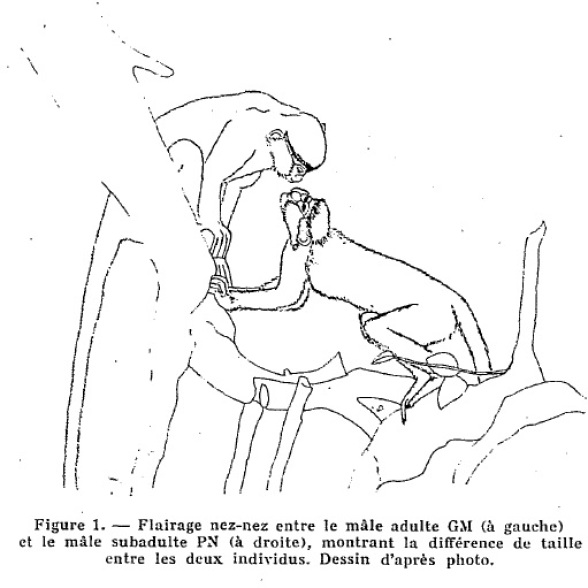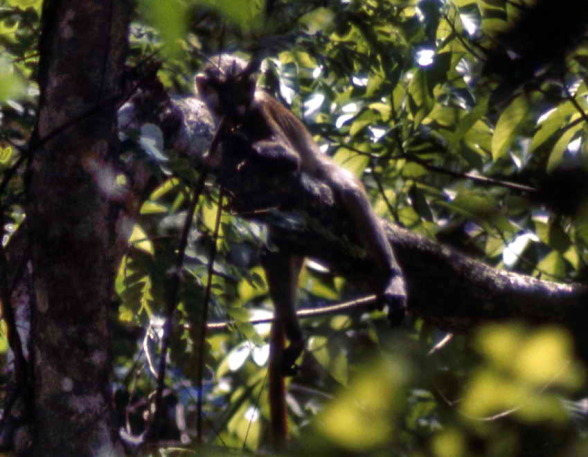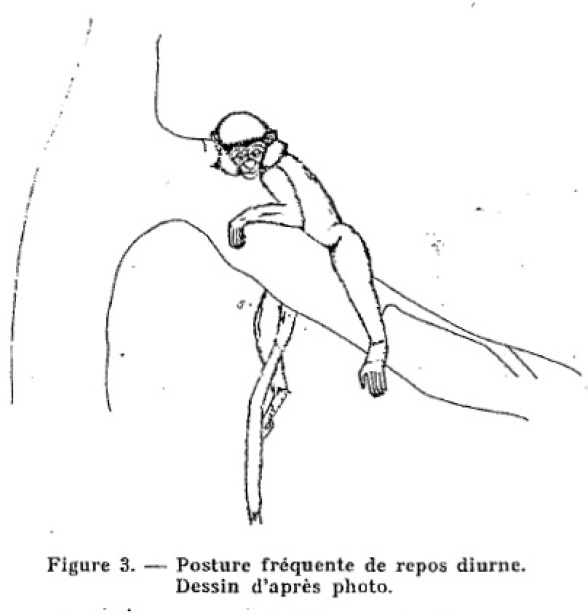Ecologie Comportement Conservation
Articles dans des revues scientifiques,
Chapitres d'ouvrages, sites web,
communications à congrès et colloques
Voir aussi:
>>> Livres, Thèses, Mémoires, Affiches, Dépliants, Bandes dessinées, Films, Reportages TV
(et aussi >>> Biomédical)
2024 :
Linder, J. M., Cronin, D.T., Ting, N., Abwe, E. E., Aghomo, F., Davenport, T.R. B., Detwiler, K. M., Galat, G., Galat-Luong, A., Hart, J. A., Ikemeh, R. A., Kivai, S. M., Koné, I., Konstant, W., Kujirakwinja, D., Long, B., Maisels, F., McGraw, W. S., Mittermeier, R. A., & Struhsaker, T. T. (2024). To conserve African tropical forests, invest in the protection of its most endangeredgroup of monkeys, red colobus. Conservation Letters, e13014. https://doi.org/10.1111/conl.13014
Open Access [pdf] Impact factor 7.126
Presse: [The Tanzania Times. Colobus Monkeys in Zanzibar provide key to save Africa's Tropical forests]
Galat-Luong A, 2024. Photos chrono-géolocalisées. In: Amazing Aberrants
2023 :
Toe Aung, Alexander K. Hill, Dana Pfefferle, Edward McLester, James Fuller, Jenna M. Lawrence, Ivan Garcia-Nisa, Rachel L. Kendal, Megan Petersdorf, James P. Higham, Gérard Galat, Adriano R. Lameira, Coren L. Apicella, Claudia Barelli, Mary E. Glenn, Gabriel Ramos-Fernandez, David A. Puts. 2023. Group size and mating system predict sex differences in vocal fundamental frequency in anthropoid primates. Nature communications. 14, 4069: 1-8. DOI https://doi.org/10.1038/s41467-023-39535-w
Open access: https://rdcu.be/dgAZY
Impact factor: 17.69. Presse (Journal de l'état de Pennsylvanie): [PennState]
Matsuda Goodwin R, Galat-Luong A, Galat G, Yao Kouakou C, Koné NA. 2023. The presence of multiple putative hybrid monkeys (Cercocebus lunulatus x Papio anubis) in a wild mangabey group suggests non-stochastic processes led to intergeneric mating. Communication. International Primatological Society - Malaysian Primatological Society (IPS - MPS) Joint Meeting 2023. Primates And People: A New Horizon.
Galat-Luong A, Galat G. 2023. Photos chrono-géolocalisées: In: Seminicolous Synnematous Trichocomaceae & Aspergillaceae
2022 :
Goodwin RM, Galat-Luong A, Galat G. (2022). Putative white-naped mangabey (Cercocebus lunulatus) × olive baboon (Papio anubis) hybrids from Comoé National Park in Côte d’Ivoire. Folia Primatologica 93 (2): 185-195. DOI: https://doi.org/10.1163/14219980-20211102
https://news.fordham.edu/science/anthropology-professor-discovers-possible-hybrid-monkey/
Galat-Luong A, Galat G. 2022. Photos chrono-géolocalisées. In: Flora of Africa from the World Geographical Scheme for Recording Plant Distributions.
2021 :
Barratt C D, Lester J D, Gratton P, Onstein R E, Kalan A K, McCarthy M S, Bocksberger G, White L C, Vigilant L, Dieguez P, Abdulai B, Aebischer T, Agbor A, Assumang A K, Bailey E, Bessone M, Buys B, Carvalho J S, Chancellor R, Cohen H, Danquah E, Deschner T, Dongmo Z N, Doumbé O A, Dupain J, Duvall C S, Eno-Nku M, Etoga G, Galat-Luong A, Garriga R, Gatti S, Ghiurghi A, Goedmakers A, Granjon A-C, Hakizimana D, Haydar N, Head J, Hedwig D, Herbinger I, Hermans V, Jones S, Junker J,, Kadam P, Kambi M, Kienast I, Kouakou C Y, N’Goran K P, Langergraber K E,, Lapuente J, Laudisoit A, Lee K C, Maisels F, Moore D†, Morgan B, Morgan D, Neil E, Nicholl S, Nkembi L, Ntongho A, Orbell C, Ormsby L J, Pacheco L, Piel A K, Pintea L, Plumptre A J, Rundus A, Sanz C, Sommer V, Sop T, Stewart F A, Sunderland-Groves J, Tagg N, Todd A, Ton E, van Schijndel J, VanLeeuwe H, Vendras E, Welsh A, Wenceslau J F C, Wessling E G, Willie J, Wittig R M, Yoshihiro N, Yuh Y G, Yurkiw K, & Boesch C, Arandjelovic M, Kühl H. 2021. Quantitative estimates of glacial refugia for chimpanzees (Pan troglodytes) since the Last Interglacial (120,000 BP). American Journal of Primatology e23320: 83 (10): 1-18. Open access. https://doi.org/10.1002/ajp.23320
Press:
WCS Newsroom Story: https://newsroom.wcs.org/News-Releases/articleType/ArticleView/articleId/16536/To-Understand-Future-Habitat-Needs-for-Chimpanzees-Look-to-the-Past.aspx
Tweet from @WCSnewsroom:https://twitter.com/WCSNewsroom/status/1429806923520651276
Instagram: https://www.instagram.com/p/CS648G5LxNX/
Facebook: https://www.facebook.com/TheWCS/photos/a.157440564269466/4778069312206545
McGraw WS, Armstrong R., Barlow C., Bersacola E., Casanova C., Galat G., Galat-Luong A., Hillyer A., Mayhew M., Minhos T., Oates J.F., Starin D. 2021. Temminck’s Red Colobus P. badius temminckii. In: LinderJ, Cronin D, Ting N, Abwe E, Davenport T, Detwiler K, Galat-Luong A, Hart J, Ikemeh R, Kivai S, Koné I, Kujirakwinja D, Maisels F, McGraw S, Oates J, Struhsaker. Red Colobus 2021. Red Colobus (Piliocolobus) Conservation Action Plan 2020-2025. IUCN Primate Specialist Group.Washington, DC: IUCN SSC . 13-16.
McGraw WS, Armstrong R., Barlow C., Bersacola E., Casanova C., Galat G., Galat-Luong A., Hillyer A., Mayhew M., Minhos T., Oates J.F., Starin D. 2021. Temminck’s Red Colobus P. badius temminckii. In: LinderJ, Cronin D, Ting N, Abwe E, Davenport T, Detwiler K, Galat-Luong A, Hart J, Ikemeh R, Kivai S, Koné I, Kujirakwinja D, Maisels F, McGraw S, Oates J, Struhsaker T. Red Colobus 2021. Red Colobus (Piliocolobus) Conservation Action Plan 2020-2025. IUCN Primate Specialist Group.Washington, DC: IUCN SSC . 13-16.
McGraw WS, Galat-Luong A, Galat G, Gonedelé Bi S., Vogt T, Oates J.F., Tayleur C., Barca B, Blasi Foglietti C, Bogt T, Greengrass L, Jones S., . 2021. Upper Guinea Red Colobus P. badius badius. In: Linder J, Cronin D, Ting N, Abwe E, Davenport T, Detwiler K, Galat-Luong A, Hart J, Ikemeh R, Kivai S, Koné I, Kujirakwinja D, Maisels F, McGraw S, Oates J, Struhsaker T. Red Colobus (Piliocolobus) Conservation Action Plan 2020-2025. IUCN Primate Specialist Group. Washington, DC. 17-18.
McGraw WS, Galat G, Galat-Luong A, Kone I, Oates JF. 2021. Miss Waldron’s Red Colobus P. waldroni. In: LinderJ, Cronin D, Ting N, Abwe E, Davenport T, Detwiler K, Galat-Luong A, Hart J, Ikemeh R, Kivai S, Koné I, Kujirakwinja D, Maisels F, McGraw S, Oates J, Struhsaker T. Red Colobus (Piliocolobus) Conservation Action Plan 2020-2025. IUCN Primate Specialist Group. Washington, DC. 19-20.
Carvalho J S, Graham B, Bocksberger G, Maisels F, Williamson E A, Wich S, Sop T, Amarasekaran B, Bergl R A, Boesch C, Boesch H, Brncic T M, Buys B, Chancellor R, Danquah E, Doumbé O A, Galat-Luong A, Ganas J, Gatti S, Ghiurghi A, Goedmakers A, Granier N, Hakizimana D, H Barbara, H Josephine, Herbinger I, Hillers A, Jones S, Manasseh E-N, McCarthy M S, Morgan B J, Nixon S, Nkembi L, Normand E, Olson S H, Payne L, Petre C-A, Piel A K, Plumptre A J, Rundus A, Serckx A, Stewart F A, Sunderland-Groves J, Tagg N, Todd A, Vosper A, Wenceslau J F C, Wessling E G, Willie J, & Kühl H. 2021. Predicting range shifts of African apes under global change scenarios. Diversity and Distributions. A Journal of Conservation Biogeography, 27: 1663–1679. DOI: 10.1111/ddi.13358 Citation Index Impact factor: 4,092
Galat-Luong A, Galat G. 2021. Photos chrono-géolocalisées: In: Afriherp.org (Africa and Herpetofauna) from the World Conservation Monitoring Centre.
Galat-Luong A, Galat G. 2021. Photos chrono-géolocalisées. In: Moths (and butterflies) of Côte d'Ivoire.
Galat-Luong A, Galat G. 2021. Photos chrono-géolocalisées. In: Biota of the WAP complex (W Arli Pendjari)
Galat-Luong A, Galat G. 2021. Photos chrono-géolocalisées. In: Flora of Africa from the World Geographical Scheme for Recording Plant Distributions.
Galat-Luong A, Galat G. 2021. Photos chrono-géolocalisées: In: Biota of the Guinean Forests of West Africa, a Global Biodiversity Hotspot.
Galat-Luong A. 2021. Photos chrono-géolocalisées. In: Owls of the World
Galat-Luong A, Galat G. 2021. Photo chrono-géolocalisée. In: First Known Photographs of Living Specimens
Galat-Luong A, Galat G. 2021. Photos chrono-géolocalisées. In: Scorpions of the World .
Galat-Luong A, Galat G. 2021. Photos chrono-géolocalisées: In: Biodiversity of Taï National Park
2020 :
Galat-Luong A, Galat G. 2020. Photographic Documentation of Scalped Olive Baboon. African Primates (14): 69. An adult male olive baboon, Papio anubis, was scalped by a lion and then followed during 14 months (14/3/2004-23/5/2005) in the WAP complex (W-Arli-Pendjari) transboundary biosphere reserve by Dr. Anh Galat-Luong and Dr. Gerard Galat, primatologists at IRD (the French Research Institute for Development). The baboon recovered without infection thanks to the care he received from the females and young of his group. Numerous photos show his taking over by a courtship of young, the progressive skin recovery, and how his hair grew again until healing. For further details, check: https://www.animalscoop.fr/mammiferes-mammals-s%C3%A4ugetiere-indexscientific-fran%C3%A7ais-english-deutsch/primatesbabouin-de-guin%C3%A9e-s%C3%A9n%C3%A9gal/babouin-doguera-4-un-m%C3%A2le-adulte-scalp%C3%A9-par-un-lion-an-adult-male-scalped-by-a-lion/.
Galat-Luong A, Galat G. 2020. Photos chrono-géolocalisées. In: Biota of the WAP complex (W Arli Pendjari)
Galat-Luong A, Galat G. 2020. Photos chrono-géolocalisées. In: Flora of Africa from the World Geographical Scheme for Recording Plant Distributions.
Galat-Luong A, Galat G. 2020. Photos chrono-géolocalisées: In: Afriherp.org (Africa and Herpetofauna) from the World Conservation Monitoring Centre.
Galat-Luong A, Galat G. 2020. Photos chrono-géolocalisées: In: Biota of the Guinean Forests of West Africa, a Global Biodiversity Hotspot.
Gonedelé Bi, S., Galat, G., Galat-Luong, A., Koné, I., Osei, D., Wallis, J., Wiafe, E. & Zinner, D. 2020. Chlorocebus sabaeus. The IUCN Red List of Threatened Species 2020: e.T136265A17958099.
Minhós, T., Ferreira da Silva, M.J., Bersacola, E., Galat, G., Galat-Luong, A., Mayhew, M. & Starin, E.D. 2020. Temminck’s Red Colobus Piliocolobus badius ssp. temminckii. The IUCN Red List of Threatened Species 2020: e.T18247A92648587. https://dx.doi.org/10.2305/IUCN.UK.2020-1.RLTS.T18247A92648587.en.
McGraw, S., Minhós, T., Bersacola, E., Ferreira da Silva, M.J., Galat, G., Galat-Luong, A., Gonedelé Bi, S., Mayhew, M., Oates, J.F. & Starin, E.D. 2020. Piliocolobus badius. The IUCN Red List of Threatened Species 2020: e.T161247840A161259430. https://dx.doi.org/10.2305/IUCN.UK.2020-1.RLTS.T161247840A161259430.en.
Folding@home Consortium et al. Galat-Luong A et al. ... 2020. Advance to understand the structures of potential drug targets for 2019-nCoV new therapies. https://foldingathome.org/2020/02/27/foldinghome-takes-up-the-fight-against-covid-19-2019-ncov/
Anh Galat-Luong. 2020. Le singe de la semaine. Société Francophone de Primatologie.
7 avril, 04:00 · Aujourd'hui dans #lesingedelasemaine...
Une bande de Mones de Lowe (Cercopithecus (campbelli) lowei), petits singes vivant dans la forêt au bord de la lagune Ebrié (Côte d'Ivoire) était fréquemment braconnée, au point que seuls quelques femelles et un très jeune mâle survivaient encore. Les mâles adultes des environs tentaient régulièrement de s’imposer à la tête du groupe. Alors que les plus jeunes femelles se montraient réceptives, la plus ancienne refusait de se laisser détrôner, conduisant à de terribles conflits qui se soldaient par des blessures. La photo montre la fille aînée qui soigne la plaie de sa mère souillée lors d'un de ces combats. Si vous cliquez sur Mone de Lowe dans l’index MAMMIFERES du site https://www.animalscoop.fr/, vous trouverez la photo de la plaie nettoyée, et d’autres belles images de cette population sauvage... aujourd'hui éteinte.
© Anh Galat-Luong-IRD 1983 #056916
Galat-Luong, A., Galat, G., Coles R, Nizinski J. 2018. Chapter 39. African Flooded Areas as Refuge Habitats. In: Primates in Flooded Habitats: Ecology and Conservation, Nowak K, Barnett AA, Matsuda I, eds. Cambridge University Press, UK. 104-114. SBN-13: 9781107134317 pre-order: Due Dec 2018 NHBS Price: £110.00 $144 €124
+ Chapter 39 Online resources at:
https://www.cambridge.org/files/8515/4461/0219/Chapter_39_Online_resources.pdf
+ Blog at:
https://www.safinacenter.org/blog/homage-to-flooded-habitats
Galat-Luong A. 2016. Oustalet’s Red Colobus Piliocolobus oustaleti Trouessart 1906. In: All the World’s Primates. Noël Rowe & Marc Myers eds. Pogonias press Charlestown, Rhode Island: 541-542.
Galat-Luong, A., Galat, G.. 2016. Guinea Baboon Papio papio Desmaret 1820. In: All the World’s Primates. Noël Rowe & Marc Myers eds. Pogonias press Charlestown, Rhode Island: 439-440.
Galat-Luong, A., Galat, G., McGraw. 2016. Spot-nosed Monkey Cercopithecus petaurista Schreber 1774. In: All the World’s Primates. Noël Rowe & Marc Myers eds. Pogonias press Charlestown, Rhode Island: 512-513.
Galat-Luong, A., Galat, G.., Starin, D. 2016. Temminck’s Red Colobus Piliocolobus temmincki Kuhl 1820. In: All the World’s Primates. Noël Rowe & Marc Myers eds. Pogonias press Charlestown, Rhode Island: 547-549.
Galat-Luong, A., Jaffe, K. E., Galat, G. 2016. Green Monkey Chlorocebus sabaeus Linnaeus 1766. In: All the World’s Primates. Noël Rowe & Marc Myers eds. Pogonias press Charlestown, Rhode Island: 477-478.
Magnuson LE, Galat G, Galat-Luong A. 2016. White-napped Mangabey Cercocebus lunulatus Temminck 1853. In: All the World’s Primates. Noël Rowe & Marc Myers eds. Pogonias press Charlestown, Rhode Island: 454-455.
McGraw, WS., Galat-Luong, A. 2016. Procolobus verus van Beneden 1838. In: All the World’s Primates. Noël Rowe & Marc Myers eds. Pogonias press Charlestown, Rhode Island: 553-554.
Galat G., Galat-Luong A., Nizinski G., Skovmand O. 2015. Influence of Increasing Dryness, Animal Feeding Strategy and Human Hunting on Large Ungulates Abundance: a First Approach in West Africa. Ekologiya Russian Journal of Ecology 46, 1: 71–80. [Pdf]
Nizinski J.J, Galat G., Galat-Luong A. 2014. Actual evapotranspiration and canopy resistance measurement of the savannah in the Kouilou basin (Congo-Brazzaville). Ekologiya Russian Journal of Ecology, 45, 5: 359–366. [Pdf]
Galat, G., Galat-Luong, A. 2013. Chlorocebus sabaeus Green Monkey (Callithrix). In : The Mammals of Africa. Vol. 2. Primates. (eds. T. M. Butynski, J. Kingdon & J. Kalina). Bloomsbury Publishing (London). 274-277.
Galat, G., Galat-Luong, A., Glenn, M., Mcgraw, S. 2013. Cercopithecus campbelli Campbell’s Monkey. In : The Mammals of Africa. Vol. 2. Primates. (eds. T. M. Butynski, J. Kingdon & J. Kalina). Bloomsbury Publishing (London). 328-330.
Galat-Luong, A., Galat, G. 2013. Papio papio Guinea Baboon. In : The Mammals of Africa. Vol. 2. Primates. (eds. T. M. Butynski, J. Kingdon & J. Kalina). Bloomsbury Publishing (London). 218-221.
Galat-Luong, A., Galat, G., Glenn, M., Mcgraw, S. 2013. Cercopithecus lowei Lowe’s Monkey. In : The Mammals of Africa. Vol. 2. Primates. (eds. T. M. Butynski, J. Kingdon & J. Kalina). Bloomsbury Publishing (London). 325-327.
Korstjens, A.H., Galat-Luong, A. 2013. Colobus polykomos King Colobus (Western Pied Colobus, Western Black-and-white Colobus). In : The Mammals of Africa. Vol. 2. Primates. (eds. T. M. Butynski, J. Kingdon & J. Kalina). Bloomsbury Publishing (London): 100-103.
McGraw, S., Galat-Luong, A., Galat, G. 2013. Cercopithecus petaurista Lesser Spot-nosed Monkey. In : The Mammals of Africa. Vol. 2. Primates. (eds. T. M. Butynski, J. Kingdon & J. Kalina). Bloomsbury Publishing (London). 381-384.
Ndiaye PI, Galat-Luong A, Galat G, Nizinski G. 2013. Endangered West African Chimpanzees Pan troglodytes verus (Schwarz, 1934) (Primates: Hominidae) in Senegal prefer Pterocarpus erinaceus, a threatened tree species, to build their nests: implications for their conservation. Journal of Threatened Taxa The International Journal on Conservation & Taxonomy. 5 (17): 5181–5304. [Pdf]
Ndiaye PI, Galat G, Galat-Luong A, Nizinski G. 2013. Note on the seasonal use of lowland and highland habitats by the West African Chimpanzee Pan troglodytes verus (Schwarz, 1934) (Primates: Hominidae): Implications for its conservation. Journal of Threatened Taxa The International Journal on Conservation & Taxonomy. 5(2): 3697–3700. [Pdf]
Galat-Luong A, Galat G, Ting N. 2012. Procolobus rufomitratus oustaleti © All the World's Primates. (alltheworldsprimates.org). N Rowe, M Myers, Eds. Primate Conservation Inc.
Junker J, Blake S, Boesch C, Campbell G, du Toit L, Duvall C, Ekobo A, Etoga G, Galat-Luong A, Gamys J, Ganas-Swaray J, Gatti S, Ghiurghi A, Granier N, Hart J, Head J, Herbinger I, Hicks TC, Huijbregts B, Imong IS, Kuempel N, Lahm S, Lindsell J, Maisels F, McLennan M, Martinez L, Morgan B, Morgan D, Mulindahabi F, Mundry R, N'Goran KP, Normand E, Ntongho A, Tiku Okon D, Petre C-A, Plumptre A, Rainey H, Regnaut S, Sanz C, Stokes E, Tondossama A, Tranquilli S, Sunderland-Groves J, Walsh P, Warren Y, Williamson EA, Kuehl HS. 2012. Recent decline in suitable environmental conditions for African great apes. Diversity and Distributions, 18 (11): 1077–1091. [Pdf]
Nizinski J. J., Galat G, Galat-Luong A. 2012. Etude de la conductivité hydraulique des troncs d’hévéa : cas d’une plantation en Côte d’Ivoire. (2) Résultats et discussion. Geographia Technica, 2: 59-67. [Pdf]
Nizinski JJ, Galat G, Galat-Luong A. 2012. Etude de la conductivité hydraulique des troncs d’hévéa : cas d’une plantation en Côte d’Ivoire. (1) Résultats et discussion. Geographia Technica 2: 61-71. [Pdf]
Galat G., Galat-Luong A., Nizinski G. 2011. Diet preferences of a Western Giant's (Lord Derby's) Eland group in a Sahelian dry habitat. Animal Biology. 61: 485–492. [Pdf]
de Jong Y, Galat-Luong A, Butynski T, Galat G, Isbell L. 2011. Erythrocebus patas patas Schreber 1775 West African Red Monkey © All the World's Primates. (alltheworldsprimates.org). N Rowe, M Myers, Eds. Primate Conservation Inc.
Galat-Luong A. 2011. Cercopithecus petaurista petaurista © All the World's Primates. (alltheworldsprimates.org). N Rowe, M Myers, Eds. Primate Conservation Inc.
Galat-Luong A, Galat G. 2011. Papio papio © All the World's Primates. (alltheworldsprimates.org). N Rowe, M Myers, Eds. Primate Conservation Inc.
Galat-Luong A, Galat G, McGraw W. 2011. Cercopithecus petaurista © All the World's Primates. (alltheworldsprimates.org). N Rowe, M Myers, Eds. Primate Conservation Inc.
Galat-Luong A, Jaffe K, Galat G. 2011. Chlorocebus sabaeus © All the World's Primates. (alltheworldsprimates.org). N Rowe, M Myers, Eds. Primate Conservation Inc.
Galat-Luong A, Galat G, Starin E. 2011. Procolobus badius temminckii © All the World's Primates. (alltheworldsprimates.org). N Rowe, M Myers, Eds. Primate Conservation Inc.
Magnuson L, Galat G, Galat-Luong A. 2011. Cercocebus atys lunulatus © All the World's Primates. (alltheworldsprimates.org). N Rowe, M Myers, Eds. Primate Conservation Inc.
Magnuson L, Galat-Luong A, Galat G. 2011. Cercopithecus campbelli lowei © All the World's Primates. (alltheworldsprimates.org). N Rowe, M Myers, Eds. Primate Conservation Inc.
McGraw W, Galat-Luong A. 2011. Procolobus verus © All the World's Primates. (alltheworldsprimates.org). N Rowe, M Myers, Eds. Primate Conservation Inc.
Nizinski G, Galat G, Galat-Luong A. 2011. Water balance and sustainability of eucalyptus plantations in the Kouilou basin (Congo-Brazzaville). Ekologiya Russian Journal of Ecology, 42 (4): 305-314. [Pdf]
Nizinski G, Galat G, Galat-Luong A. 2011, Bioclimatological analysis of the bark necrotic rubber tree in Côte d'Ivoire plantations. Russian Agricultural Sciences, 37 (1): 58-67. [Pdf]
Nizinsky J, Galat G, Galat-Luong A. 2010. Continents under climate change : conference on the occasion of the 200th anniversary of the Humboldt-Universität zu Berlin : abstracts of lectures and posters of the conference.
Nizinsky J, Galat G, Galat-Luong A. 2010. Climate change and sustainability of Eucalyptus plantations in the Kouilou basin (Congo-Brazzaville). In : Endlicher W, Gerstengarbe F.W. (eds) Continents under climate change : conference on the occasion of the 200th anniversary of the Humboldt-Universität zu Berlin : abstracts of lectures and posters of the conference. Potsdam : PIK 115: 75.
Nizinsky J, Galat G, Galat-Luong A. 2010. Interest using the Bowen-ratio method to study the actual evapotranspiration of the savannah in the climate change contex (The Kouilou basin, Congo-Brazzaville). In : Endlicher W, Gerstengarbe F.W. (eds) Continents under climate change : conference on the occasion of the 200th anniversary of the Humboldt-Universität zu Berlin : abstracts of lectures and posters of the conference. Potsdam : PIK 115: 76. Conference on the Occasion of the 200th Anniversary of the Humboldt-Universität zu Berlin, Berlin.
Nizinski Galat Galat-Luong. 2010. Etude et modélisation de l’évapotranspiration des couverts végétaux cas d’une savane et d’une plantation. In: V Dubreuil, O Planchon, H Quenol et V Bonnardot (eds), Actes du XXIIIème Colloque de l’Association Internationale de Climatologie « Risques et changement climatique », LETG (UMR 6554 CNRS), Université Européenne de Bretagne, Rennes 2, Rennes,: pp. 451-456.
Nizinski J, Galat-Luong A, Galat G, Lhomme J-P. 2010. L'intérêt de l'utilisation in situ des micropsychromètres de Dixon-Tyree en bioclimatologie : cas d'une plantation d'hévéa en Côte d'Ivoire. Climatologie, 7: 109-121. [Pdf]
Galat G., Galat-Luong A., Nizinski G. 2009. Increasing dryness and regression of the geographical range of Temminck’s red colobus Procolobus badius temminckii: implications for its conservation. Mammalia 73: 365-368. [Pdf]
Galat G., Galat-Luong A., Nizinski G. 2009. L’impact du changement climatique sur les variations des populations de grands vertébrés à leur extrême limite de répartition est-il fonction de leurs régimes alimentaires ? Geographia Technica Numéro spécial : 205-210. [Pdf]
Galat-Luong A, Galat G., Nizinski G. 2009. Une conséquence du réchauffement climatique : les chimpanzés filtrent leur eau de boisson. Geographia Technica No spécial : 199-204. ISSN 2065-4421. [Pdf]
Nizinski J.J., Galat G., Galat-Luong, A. 2009. Aspects bioclimatologiques de la nécrose corticale de l'hévéa en Côte d’Ivoire. Geographia Technica Numéro spécial : 355-360. [Pdf]
Nizinski J.J., Galat-Luong A., Galat G., Dingkuhn M., Fabre D. 2009. Evapotranspiration réelle et résistance du couvert d'une savane à Loudetia arundinacea (bassin du Kouilou, Congo-Brazzaville). Climatologie, 6, p. 33-45. [pdf]
Galat-Luong, A. & collectif du Comité français UICN. 2008. Plan d’action Actions internationales. In : Stratégie nationale pour la biodiversité Bilan 2007. Rapport complet par plan d’action (document d’expertise pour le Ministère de l'Ecologie) : 29-36.
Galat-Luong, A., Galat, G., Oates, J.F., Struhsaker, T., McGraw, S. & Ting, N. 2008. Procolobus badius ssp. temminckii. In: IUCN 2008. 2008 IUCN Red List of Threatened Species. http://www.iucnredlist.org/details/18247/0.
Nizinski JJ, Morand D., Loumeto J.-J., Galat-Luong A., Galat G. 2008. Bilan hydrique comparé d’une savane et d’une plantation dans le basin du Kouilou (Congo-Brazzaville), Climatologie, 5 : 99-112. [pdf]
Oates, J.F., Struhsaker, T., McGraw, S., Galat-Luong, A., Galat, G. & Ting, T. 2008. Procolobus badius. In: IUCN Red List of Threatened Species. <http://www.iucnredlist.org/>
Galat, G., Galat-Luong, A. 2007. Connaître et faire connaître l'aire protégée : une plaquette et un guide pour les visiteurs, les décideurs et les populations résidentes. Résumé. In : Quelles aires protégées pour l’Afrique de l’Ouest ? Conservation de la biodiversité et développement. Fournier A., Sinsin B., Mensah G. A., Eds. CD Rom Collection : Colloques et séminaires. IRD. Paris : 528-529. [pdf]
Galat, G., Galat-Luong, A. 2007. Introducing the protected area. A brochure and a guide for visitors, decision-makers and residents. Abstract. In : Quelles aires protégées pour l’Afrique de l’Ouest ? Conservation de la biodiversité et développement. Fournier A., Sinsin B., Mensah G. A., Eds. CD Rom Collection : Colloques et séminaires. IRD. Paris : 570.
Galat, G., Galat-Luong, A., Lavocat, B. 2007. Influence des premières pluies sur la répartition des grands Mammifères. Résumé. In : Quelles aires protégées pour l’Afrique de l’Ouest ? Conservation de la biodiversité et développement. Fournier A., Sinsin B., Mensah G. A., Eds. CD Rom Collection : Colloques et séminaires. IRD. Paris : 526-527. [pdf]
Galat-Luong, A., Galat, G. 2007. Proximité des aires protégées et perception du tourisme et de l’exploitation de la faune par les populations résidentes. In : Quelles aires protégées pour l’Afrique de l’Ouest ? Conservation de la biodiversité et développement. Fournier A., Sinsin B., Mensah G. A., Eds. CD Rom Collection : Colloques et séminaires. IRD. Paris : 458-467, 528. [pdf]
Galat-Luong, A., Galat, G. 2007. Influence de l’anthropisation sur la répartition de la grande faune. La mangrove, un milieu refuge. Résumé. In : Quelles aires protégées pour l’Afrique de l’Ouest ? Conservation de la biodiversité et développement. Fournier A., Sinsin B., Mensah G. A., Eds. CD Rom Collection : Colloques et séminaires. IRD. Paris : 527. [pdf]
Galat-Luong, A., Galat, G. 2007. The proximity of protected areas and the perception of tourism and the exploitation of wildlife by the local inhabitants. Abstract. In : Quelles aires protégées pour l’Afrique de l’Ouest ? Conservation de la biodiversité et développement. Fournier A., Sinsin B., Mensah G. A., Eds. CD Rom Collection : Colloques et séminaires. IRD. Paris : 569. South East of Senegal shows a large mammals fauna of an exceptional specific richness: we identified 53 species of large and medium Mammals. We investigated 101 villages, and 89 % of them notice and regret a degradation of their natural environment. All the ethnic groups consume game (results based on the statements of the interrogated groups and not on a measure of consummated quantities). Only a fifth of the interrogated villages declares not to consume it. Villages situated near or within an area managed for the wild fauna consume more. If considering hunting and ecotourism development seems globally rather negative, it is not any more case as soon as the populations live near a protected area or near a hunting safari camp and already have an experience of this type of activities. 84 % of the interrogated villages wish to have a game ranching activity. Proposed to breed animal species are those preferred for the consumption and those for which breeding is actually possible (except the porcupine) : Bushbuck, Red-flanked Duiker, Guinea fowl, Hare (to replace with Rabbit) and Roan Antelope. Fauna conservation owes and can today be economically profitable. A natural system of production constituted with areas managed for their fauna, exploited for the benefit of the local populations and compatible with ecosystem conservation, could have an alternate return of investment compared to industrial farming. Organized hunting and ecotourism, cattle farms and fauna reserves can generate important incomes. The example of the implementation of Dindéfelo's APC, which has been created on a cooperative basis by the local population, proves that this way can be followed. It would be advisable to do so before the faunal natural resource disappears, that is immediately. Grants IRD, AFD, DDR.
Galat-Luong, A., Galat, G. 2007. Influence of anthropization on the distribution of the large wildlife. The mangroves, a refuge environment. Abstract. In : Quelles aires protégées pour l’Afrique de l’Ouest ? Conservation de la biodiversité et développement. Fournier A., Sinsin B., Mensah G. A., Eds. CD Rom. Collection : Colloques et séminaires. IRD. Paris : 568-569. The Delta du Saloum National park (Senegal) mangrove swamp, although threatened by an excessive exploitation, shows yet a diverse fauna of large mammals. Certain species of large and medium herbivore (Manatee) or carnivore (white cheeks Otter, swamp Mongoose, which consume essentially fishes, eggs, mollusks and shellfishes) Mammals are there enfeoffed. The small nocturnal carnivores (Mongooses, Wildcat, Genets) feed on fishes, invertebrates and small birds. As a result of the increase of the human pressure, new species included this particular environment in their home range. Our study, led in 1975-1976, showed that Green Monkeys adapted well to this habitat. They stay there up to 80 % of their time and feed on different parts of Rhizophora trees and prey on Uca tangeri crabs. Sitatunga, that one thought extinct in Senegal since thirty years, was rediscovered there during the 1998 IRD-DPN-DEFCC-IUCN census, in very small and fragmented populations. This demonstrates the efficiency of mangrove swamps as refuge. More recently, new species (Patas monkey, Bushbuck, and Warthog since about ten years ; Guinea fowl and especially Red Colobus for about five years) enter the mangrove swamp and find there protection against disturbances caused by man. Their predators, Civet and Hyena, follow them there. Sitatunga and Red Colobus survive in particularly confined and fragmented populations. Climatic change (dryness) and especially anthropisation (loss of continental habitats through deforestation, human activities disturbances) affected the mangrove swamp ecosystem which saw, in a short time, an increase of the large vertebrates diversity. This increase is however misleading, because it is only due to concentration of threatened species in their last refuge. Grants: IRD, IUCN. Thanks : DPNS, PNDS Curator and rangers.
Galat G., Galat-Luong A., Nizinski G. 2007. Chimpanzees and baboons face global warming by digging wells to filtrate drinking water. In: Global changes and water resources: confronting the expanding and diversifying pressures, Varis O, Tortajada C, Chevallier P, Pouyaud B, Servat E eds. 13p pdf. CDROM VERSeau Développement, Montpellier. [pdf]
Galat G, Galat-Luong A, Lavocat B. 2007. Influence of the first rains on the distribution of the large mammals. In : Quelles aires protégées pour l’Afrique de l’Ouest ? Conservation de la biodiversité et développement. Fournier A, Sinsin B, Mensah GA, Eds. CD Rom Collection : Colloques et séminaires. IRD. Paris : 568. Density and biomass of the large Mammals of a puddle of a flood plain (Simenti, Gambia River, Niokolo Koba National park, Senegal) were estimated during the dry - rainy seasons transition. Objective was to analyze the impact of the first rains on the distribution of the large Mammals. Density in the immediate neighborhoods of the puddle was estimated on the basis of 433 contacts of individuals or groups, which have allowed to localize 926 animals by the transects lines method. In the puddle surroundings, the Mammal density is twice as high as in the rest of the Park. From May till July, 1997, 3,367 records (scanning) in the puddle allowed to collect 36,897 observations of ten species of large Mammals. In the poodle, the six most abundant species, Kob and Warthog (80 % of the total), Bushbuck, Defassa Waterbuck, Baboon and Green Monkey, represent an average density of 86 individuals by km2 for a biomass of 4,320 kg / km2. Four days after the first rainfalls, Mammal biomass decreases strongly. Four of the less abundant species (Patas monkey, Red-flanked Duiker, Oribi and Western Hartebeest) leave the puddle. Biomass stabilizes then after a light increase. The speed of the seasonal modifications of the distribution of the large Mammals must be taken into account in the management plans of the protected areas. Grants IRD. Thanks National Parks of Senegal, Niokolo Koba and Badiar National Parks Curators and rangers.
Galat, G., Galat-Luong, A. 2006-7. Des mangabés couronnés découverts au Burkina Faso. Conservation des espèces et des populations animales. 15 : 10-11. [pdf]
Des singes luttent pour leur survie. 2006. Fiche d’actualité IRD 238. 2p.
Galat, G. 2006. Un singe en danger d’extinction trouve refuge au Burkina Faso. Sciences au Sud. 37 : 3.
Galat, G., Galat-Luong, A. 2006. Hope for the survival of the Critically Endangered white-napped mangabey Cercocebus atys lunulatus: a new primate species for Burkina Faso. Oryx, The International Journal of Conservation. 40 (3): 355-357. [pdf]
Galat-Luong, A. Galat, G. 2006. Résistance pugnace des colobes bais du Saloum. Sciences au Sud. 35 : 7.
Galat-Luong, A., Galat, G., Hagell, S. 2006. The Social and Ecological Flexibility of Guinea Baboons: Implications for Guinea Baboon Social Organization and Male Strategies. In: Reproduction and fitness in Baboons: Behavioral, Ecological, and Life History Perspectives. L Swedell, S Leigh eds. Springer, New York: 105-121.
IUCN, Species Survival Commission. 2006. 2006 IUCN Red List of threatened Species. http://www.redlist.org/
Galat-Luong, A., Galat, G. 2005. Conservation and survival adaptations of the Temminck's red colobus, (Procolobus badius temmincki), in Senegal. International Journal of Primatology, 26 (3): 585-603. [pdf]
Il y a plus de 20 ans, nous écrivions:
Galat-Luong, A., Galat, G. 2003. Des recherches biomédicales à la conservation de la biodiversité: leçons. IRD UR 136. Orléans.
Les pneumopathies atypiques sont aujourdhui identifiées: H1N1 et suivants, SARS, SARS-COV
Publications de vulgarisation à télécharger:
Galat, G., Galat-Luong, A., Pichon, G., Mboup, S., Rey, J. -L. 1993. Des singes et des rétrovirus. ORSTOM actualités 40: 13-20. [pdf]
Galat, G., Galat-Luong, A. 1997. Circulation des virus en milieu tropical, socio-écologie des Primates et équilibre des écosystèmes. Cahiers santé, Santé : Cahiers d'Etudes et de Recherches Francophones 7 (2) : 81-87. [pdf]
IUCN collectif. 1991. Caring for the Earth, A Strategy for Sustainable living. IUCN - UNEP - WWF Eds, 228p.
UICN collectif. 1991. Sauver la Planète; Stratégie pour l'Avenir de la Vie. UICN - PNUE - WWF Eds, 250p.
Comité français UICN. 2003. Au nom du vivant. Contribution à la Stratégie Nationale pour la biodiversité. Premier Ministre - Conseil National du Développement Durable. 56p.
Galat, G. 2003. La biodiversité de la grande faune du Sénégal oriental : une richesse à préserver et à exploiter. In : Potentialités, contraintes et systèmes d’exploitation au Sénégal Oriental et en Haute Casamance. CD-ROM. Direction du Développement Rural/Sodefitex-Université Cheikh Anta Diop eds. Dakar.
Galat-Luong, A. 2003. La perception de la faune sauvage du Sénégal oriental par les populations résidentes : des potentialités pour une gestion durable. In : Potentialités, contraintes et systèmes d’exploitation au Sénégal Oriental et en Haute Casamance. CD-ROM. Direction du Développement Rural/Sodefitex-Université Cheikh Anta Diop eds. Dakar.
Galat-Luong, A., Galat, G., 2003. Dossier Babouins. Régression du Babouin de Guinée, Papio papio, en Afrique de l’Ouest. Bull. Soc. Francophone de Primatologie. 17 : 10.
Galat-Luong, A., Galat, G. 2003. Social and ecological flexibility in Guinea baboons as an adaptation to unpredictable habitats. Abstract. American Journal of Physical Anthropology. 120 (S36): 98.
Galat-Luong, A., Galat, G. 2003. Conservation and survival adaptations of the Western Red Colobus (Colobus badius temmincki) in Senegal. Abstract. American Journal of Primatology. 60 (1): 87.
Galat-Luong, A., Galat, G. 2003. La ressource grande faune terrestre du Sénégal oriental : ses potentialités, ses contraintes. Fichier pdf 96p. In : Potentialités, contraintes et systèmes d’exploitation au Sénégal Oriental et en Haute Casamance. CD-ROM. Direction du Développement Rural/Sodefitex-Université Cheikh Anta Diop eds. Dakar.
Skovmand, O., Galat, G., Galat-Luong, A. 2003. Le risque acridien au Sénégal oriental. Fichier pdf imprimable 34p. In : Potentialités, contraintes et systèmes d’exploitation au Sénégal Oriental et en Haute Casamance. CD-ROM. Direction du Développement Rural/Sodefitex-Université Cheikh Anta Diop eds. Dakar.
Galat-Luong, A., Galat, G. (2003a). - Social and ecological flexibility in Guinea baboons as an adaptation to unpredictable habitats. Symposium Life History, Reproductive Strategies, & Fitness in Baboons, 72nd annual meeting of the American Association of Physical Anthropologists. 23-26/4. Tempe, USA.
Galat-Luong, A., Galat, G. (2003b). - Conservation and survival adaptations of the Western Red Colobus at its most northern distribution limit in Senegal. African Monkey Conservation symposium. 26th Annual Conference of the American Society of Primatologists. 31/7-2/8. Calgary, Canada.
Galat-Luong, A., Galat, G. (2003c). - Influence de l'anthropisation sur la répartition de la grande faune: la mangrove, un milieu refuge. Séminaire régional sur l’aménagement et la gestion des aires protégées d’Afrique de l’Ouest. 14-19/4. Parakou, Bénin.
Galat-Luong, A., Galat, G. (2003). - Influence de la proximité des Aires gérées pour la faune sur la perception du tourisme et de la chasse sportive touristique par les populations résidentes. Séminaire régional sur l’aménagement et la gestion des aires protégées d’Afrique de l’Ouest. 14-19/4. Parakou, Bénin.
Galat, G., Galat-Luong, A. (2003d). - Connaître et faire connaître l'aire protégée : une plaquette et un guide pour les visiteurs, les décideurs et les populations résidentes. Séminaire régional sur l’aménagement et la gestion des aires protégées d’Afrique de l’Ouest. 14-19/4. Parakou, Bénin.
Galat, G., Galat-Luong, A., Lavocat, B. (2003). - Influence des premières pluies sur la répartition des grands Mammifères. Séminaire régional sur l’aménagement et la gestion des aires protégées d’Afrique de l’Ouest. 14-19/4. Parakou, Bénin.
IUCN. 2001. Categories & Criteria (Version 3.1). http://www.redlist.org/info/ categories_criteria2001.html.
Galat, G. (2001). La biodiversité de la grande faune du Sud-est du Sénégal : une richesse à préserver et à exploiter. Réunion de restitution IRD - UCAD - Sodefitex. Tambacounda, Sénégal.
Moisson, P., Gautier-Hion, A., Colyn, M., Auzel, P., Galat-Luong, A., Galat, G. (2001) - Table ronde: Viande de brousse. XIIIe Colloque de la Société Francophone de Primatologie. 24-26/9. Université de Rennes 1.
Galat, G., Galat-Luong, A., Ndiaye, I., Keita, Y. 2000. Geographical distribution of Chimpanzees and Baboons in Senegal. Folia Primatologica. 71: 257. [pdf]
Galat-Luong, A. 2002. Antilope en péril. Sciences au Sud. 13 : 4.
Galat, G, Galat-Luong, A. 2000. Abondance et degré de menace des grands mammifères terrestres du Sénégal. In : Annuaire sur l’environnement et les ressources naturelles du Sénégal. CSE. Dakar : 97-99.
Groupe d’experts des plaines d’inondation sahéliennes. 2000. Vers une gestion durable des plaines d’inondation sahéliennes. UICN, Gland, Cambridge. 214p.
Galat-Luong, A. 2000. Gestion de la diversité biologique. In : Vers une gestion durable des plaines d’inondation sahéliennes. Groupe d’experts des plaines d’inondation sahéliennes. UICN, Gland, Suisse et Cambridge, UK. : 100-103. [extrait:]
DPN, ISE, IRD. 2000. Plan de Gestion du Parc national du Niokolo Koba. MEPN, Dakar.
Galat-Luong, A., Galat, G. 2000. Chimpanzees and baboons drink filtrated water. Folia Primatologica. 71: 258. [pdf]
ISE, IRD, MEPN, UICN. 2000. Plan de Gestion de la Réserve de Biosphère du Delta du Saloum. Vol 2 : Zonage et plan d’action Coordination scientifique ISE - IRD - MEPN - UICN. UICN, Dakar. 58 p.
ISE, IRD, MEPN, UICN. 2000. Plan de Gestion de la Réserve de Biosphère du Delta du Saloum. Vol 1: Diagnostic. Coordination scientifique ISE - IRD - MEPN - UICN. UICN, Dakar. 128 p.
IUCN, Species Survival Commission. 2000. 2000 IUCN Red List of threatened Animals. www.redlist.org.
Galat, G., Galat-Luong, A., Keita, Y. 1999-2000. Régression de la distribution et statut actuel du Babouin, Papio papio, en limite d’aire de répartition au Sénégal. African Primates 4 (1&2) : 69-70.
Galat-Luong, A., Galat, G., Ndiaye, I., Keita, Y. 1999-2000. Fragmentation de la distribution et statut actuel du Chimpanzé, Pan troglodytes verus, en limite d’aire de répartition au Sénégal. African Primates 4 (1&2) : 71-72.
Chimpanzés et Babouins filtrent leur eau de boisson. 1999. Fiche d’actualité IRD 99. 2p.
IUCN, Species Survival Commission Ed. 1999. IUCN Red List Criteria-review provisional report. Gland. 21p.
Galat, G., Galat-Luong, A., Ndiaye, I., Keita, Y. (1999). - Distributions actuelles du Chimpanzé et du Babouin au Sénégal. De l’animal à l’homme : passé, présent et avenir, XIe Colloque de la Société Francophone de Primatologie. Paris.
Galat-Luong, A., Galat, G. (1999). - Chimpanzés et Babouins filtrent leur eau de boisson. De l’animal à l’homme : passé, présent et avenir, XIe Colloque de la Société Francophone de Primatologie. 28/9-2/10. Paris.
Mbaye, I., Galat, G., Galat-Luong A. 1998. Etat de conservation des Antilopes sahélo-sahariennes du Sénégal et de leurs habitats actuels ou potentiels. In : Conservation et Restauration des Antilopes sahélo-sahariennes. CMS Technical series 3. Convention on migratory species. Djerba : 81-88.
Collectif. 1998. Plan de Gestion du Complexe Ecologique du Niokolo-Badiar, Sénégal – Guinée. Fonds Européen de Développement régional No 4213/REG.
Galat, G., Galat-Luong, A., Lavocat, B. (1998). - Densité et biomasse de la grande faune mammalienne d’une mare de plaine d’inondation (Simenti, fleuve Gambie, Parc national du Niokolo Koba, Sénégal). IIe Conférence internationale sur les zones humides et le développement. 9-14/11. Dakar, Sénégal.
Galat-Luong, A., Galat, G., Mbaye, M., Ba, S., Rigoulot, Jb. (1998). - L’utilisation d’une mangrove (Parc national du Delta du Saloum, Sénégal) par la grande faune mammalienne. IIe Conférence internationale sur les zones humides et le développement. 9-14/11. Dakar, Sénégal.
Galat, G., Galat-Luong, A. 1997. Circulation des virus en milieu tropical, socio-écologie des Primates et équilibre des écosystèmes. Cahiers santé, Santé : Cahiers d'Etudes et de Recherches Francophones 7 (2) : 81-87
Galat-Luong, A., Galat, G. 1997. Les Primates. In: Monographie sénégalaise de la Diversité biologique. Ministère de l’Environnement et de la Conservation de la Nature du Sénégal - PNUE : 42.
Galat, G., Galat-Luong, A. 1997. La faune, l’Homme et leur milieu. La Primatologie. In : 50 années de recherches en coopération au Sénégal. ORSTOM Dakar : 140-141.
Galat, G., Galat-Luong, A., Chevillotte, H. 1997. La faune, l’Homme et leur milieu. Recensements de faune en milieux terrestres. In : 50 années de recherches en coopération au Sénégal. ORSTOM Dakar : 138-139.
Galat-Luong, A. 1997. Les mammifères de la réserve. In: Le sentier écologique de la réserve de Mbour, Sénégal. ORSTOM - DPNS - UICN Ed.: 37-45.
Checklist of CITES Species. 1996. CITES ed.
Diouck, D., Galat-Luong, A., Galat, G. 1996. The Fathala forest Red colobus (Colobus badius temmincki): twenty years of Delay. Folia Primatologica 67 (2) : 89.
Galat, G. 1996. Primates socio - ecology, Ecosystem balance and virus circulation. Folia Primatologica. 67 (2) : 94.
Galat, G., Galat-Luong, A. 1996. Social organization and SIV seroprevalence of Green and Patas monkeys. Folia Primatologica. 67 (2) : 91.
Galat-Luong, A. 1996. Interspecific transmission of SIV from Green to Patas monkeys: from behaviour to molecular biology. Folia Primatologica. 67 (2) : 93-94.
Galat-Luong, A., Galat, G., Durand, J. -P., Pourrut, X. 1996. Sexual weight dimorphism and social organisation in Green and Patas monkeys in Senegal. Folia Primatologica. 67 (2): 92-93.
IUCN - Species Survival Commission Primate Specialist Group. Compiled by John Oates. 1996. African Primates : Status Survey and Conservation Action Plan ; Revised Edition. 80p.
IUCN, Species Survival Commission Ed. 1996. 1996 IUCN Red List of threatened Animals. Gland. 378p.
Pourrut, X., Galat-Luong, A., Galat, G. 1996. Associations du Singe vert avec d’autres espèces de Primates au Sénégal: la transmission interspécifique du SIVagm doit être fréquente dans la nature. Revue de médecine vétérinaire 147 (1): 47-58. [pdf]
Galat, G., Galat-Luong A. (1996). - Faune et écotourisme au Complexe écologique transfrontalier du Niokolo-Badiar. Séminaire sous-régional (Guinée - Guinée Bissau - Gambie - Mali - Sénégal) Parcs nationaux et écotourisme. 10-14/7. Simenti, Sénégal.
Galat-Luong, A. 1995. Niokolo Koba. Dénombrement de la faune du Parc national. Echanges. 1: 2.
Galat-Luong, A. 1995. Du statut et de l'avenir des Primates au Sénégal. African Primates. 1 (1): 12-13. [pdf]
IUCN - Species Survival Commission. 1995. The new African Primates Conservation Action Plan. 23p.
Diouck, D., Galat-Luong, A., Galat, G. (1995). - Les Colobes bais (Colobus badius temmincki) de la forêt de Fathala: vingt ans de sursis. VIIe Colloque de la Société Francophone de Primatologie. Toulouse, France.
Galat, G. (1995). - Socio-écologie des Primates in natura, équilibre des écosystèmes et circulation des virus. VIIe Colloque de la Société Francophone de Primatologie. Toulouse.
Galat, G., Galat-Luong, A. (1995). - Organisation sociale et séroprévalence SIV chez le Singe vert et le Patas. VIIe Colloque de la Société Francophone de Primatologie. 13-14/10. Toulouse, France.
Galat-Luong, A., Galat, G., Durand, J. -P., Pourrut, X. (1995). - Dimorphisme sexuel pondéral et organisation sociale chez le Singe vert et le Patas au Sénégal. VIIe Colloque de la Société Francophone de Primatologie. Toulouse, France.
Diop, O., Gogovor, H., Galat-Luong, A., Durand, J. -P., Le Guenno, B. Michel, P., Akakpo, A., Galat, G. 1994. Sexual transmission and transmission by biting of SIVagm among captive green monkeys, Cercopithecus æthiops sabæus. Folia Primatologica. 62 (4): 195-196.
Galat, G., Galat-Luong, A., Benoit, M., Chevillotte, H., Diop, A., Duplantier, J. -M., Pichon, G. 1994. Primates density in the Niokolo Koba National Park, Senegal. Folia Primatologica. 62 (4): 197.
Galat, G., Galat-Luong, A., Pichon, G., Bibollet-Ruche, F., Pourrut, X., Senzani, M. 1994. Prévalence SIV chez les Cercopithécidés de savane au Sénégal: l'approche socio-écologique. In: Priorités de recherche sur le VIH en Afrique. African AIDS Research Network, Dakar: 121-129.
Galat-Luong, A. 1994. Dorsal infant carrying in the wild Patas monkeys, Erythrocebus patas, in Senegal. Folia Primatologica. 62 (4): 197-198.
Galat-Luong, A., Galat, G., Bibollet-Ruche, F., Durand, J. -P., Diop, O., Pourrut, X., Sarni-Manchado, P., Senzani, M., Pichon, G. 1994. Social structure and SIVagm prevalence in two groups of green monkeys, Cercopithecus æthiops sabæus, in Senegal. In: Current Primatology, Behavioural Neuroscience, Physiology and Reproduction. Anderson JR, Roeder JJ, Thierry B and Herrenschmidt N, Eds. Vol. III. ULP, Strasbourg: 259-262.
Galat-Luong, A., Bibollet-Ruche, F., Pourrut, X., Durand, J. -P., Sarni, P., Pichon G., Galat, G. 1994. Social organisation and SIV sero-epidemiology of a Patas monkey population in Senegal. Folia Primatologica. 63 (4): 226-228. [pdf]
Groupe d’experts des plaines d’inondation sahéliennes. 1994. Manuel de formation à la gestion des zones humides tropicales. UICN, Gland. 274p.
IUCN - Species Survival Commission - Specialist Group on Sustainable Use of Wild Species. 1994. An initial Procedure for assessing the Sustainability of Uses of Wild Species. 24p.
Galat-Luong, A., Launois, M., Treca, B. 1994. L'Ornithologue, le Primatologue et le Criquet pèlerin. SAS 94 - Surveillance des acridiens au Sahel. 1: 6.
Galat-Luong, A., Chiasera S., Galat, G., 1994. - What future for Red colobus north of the Gambia river? XVth Congress of the International Primatological Society. Bali.
Galat-Luong, A., Galat, G., 1994a. - 15 years decline of the most northern west african population of Green monkeys. XVth Congress of the International Primatological Society. Bali.
Galat-Luong, A., Galat, G., 1994b. - Troop Size, Home Range and Density of the Olive Colobus in the Tai National Park, Ivory Coast. XVth Congress of the International Primatological Society. Bali, Indonésie.
Galat-Luong, A., Pourrut X., Galat, G., 1994a. - Green Monkeys, Patas and Red Colobus plurispecific associations. XVth Congress of the International Primatological Society. Bali, Indonésie.
Galat, G., Galat-Luong, A., Pichon, G., Mboup, S., Rey, J. -L. 1993. Des singes et des rétrovirus. ORSTOM actualités 40: 13-20. [pdf] Extraits ci-dessous:
IUCN - Species Survival Commission-Specialist Group on Sustainable Use of Wild Species. 1993. Guidelines for the Ecological Sustainability of Nonconsumptive and Consumptive Uses of Wild Species.
Galat, G., Galat-Luong, A., Benoit, M., Chevillotte, H., Diop, A., Duplantier, J. -M., Pichon, G. (1993). - Densité des Primates du Parc National du Niokolo Koba, Sénégal. Ve Colloque de la Société Francophone de Primatologie. Paimpont, France.
Galat, G., Galat-Luong, A. 1992. Ecologie des singes d'Afrique de l'Ouest: intérêt pour la compréhension du SIDA humain. In: Pourquoi des recherches sur le SIDA en Afrique? Programme SIDA de l'ORSTOM, Montpellier: 5-23.
IUCN - Species Survival Commission-Specialist Group on Sustainable Use of Wild Species. 1992. Criteria and Requirements for Sustainable use of Wild Species. IUCN.
Galat, G., Galat-Luong, A. (1992). - Le partage des ressources chez le Singe vert, Cercopithecus æthiops sabæus, au Sénégal. XIVth Congress of the International Primatological Society, Strasbourg, France.
Galat-Luong, A., Galat, G., Bibollet-Ruche, F., Durand, J. -P., Diop, O., Pourrut, X., Sarni-Manchado, P., Senzani, M., Pichon, G. (1992). - Structure sociale et prévalence de SIVagm de deux bandes de Singes verts, Cercopithecus æthiops sabæus, au Sénégal. XIVth Congress of the International Primatological Society, Strasbourg, France.
Galat-Luong, A. 1991. Proies inhabituelles pour le Patas d'Afrique de l'Ouest (Erythrocebus patas patas). Revue d'Ecologie (Terre et Vie). 46 (1): 83-84.
Galat-Luong, A. 1991. L'Ascagne et les Cercopithèques du groupe cephus. L'espace zoologique. 21: 8-11. [pdf]
IUCN. 1991. Caring for the Earth, A Strategy for Sustainable living. IUCN - UNEP - WWF Eds, 228p.
UICN - Commission de Survie des Espèces. 1991. Critères et exigences pour l’utilisation durable des espèces sauvages. Proposition de politique UICN pour la Conservation mondiale. Victoria, Canada. 21p.
UICN. 1991. Sauver la Planète; Stratégie pour l'Avenir de la Vie. UICN - PNUE - WWF Eds, 250p.
Galat-Luong, A., Galat, G. (1991). - Contacts et distances interindividuels chez le Singe vert, Cercopithecus æthiops, au Sénégal. VIe Conférence Internationale sur le SIDA en Afrique. Dakar, Sénégal.
IUCN. 1990. Caring for the World, A Strategy for Sustainability. IUCN - UNEP - WWF Eds, 135p.
Mühlenberg, M., Galat-Luong, A., Poilecot, P., Steinhauer-Burkart, B., Kühn, I. 1990. L'importance des îlots forestiers de savane humide pour la conservation de la faune de forêt dense. Revue d'Ecologie (Terre et Vie), 45: 40-57. [pdf]
Galat-Luong, A., Galat, G. 1990. Etude de l'impact de la mise en exploitation du fer des Monts Nimba en Guinée sur les Primates. in: Projet minier des Monts Nimba. Evaluation environnementale de 1990. Première partie : état initial du site et de son environnement (Annexe). BCEOM - NIMCO - MAB/UNESCO, Montpellier : 150-182.
UICN. 1990. Servir la Planète. Une stratégie pour demain. UICN - PNUE - WWF Eds. 217p.
World Bank-World Resources Institute - IUCN - Conservation International - WWF, Eds. 1990. Conserving The World's Biological Diversity. 193p.
World Conservation Monitoring Center - Conservation International - IUCN - WWF - World Resources Institute - The International Council for Bird Preservation Eds. 1990. Biodiversity in Sub-Saharan Africa and its Islands; Conservation, Management and Sustainable Use. 242p.
Galat, G. 1989. Vivre en bandes et survivre. Nature et Faune (FAO). 5 (2): 14-27. [pdf]
Galat-Luong, A. 1988. Monkeys in the Pirang forest. In: Pirang. Ecological Investigations in a Forest Island in the Gambia. Ellenberg, H., Galat-Luong, A., Von Maydel, H. -J., Mühlenberg, M., Panzer, K. F., Schmidt-Lorenz, R. S., Sumser, M., Szolnoki, T. W. Eds. Stiftung Walderhaltung in Afrika, Hamburg, und Bundesforschungsanstalt für Forst- und Holzwirtschaft, Hamburg, Warnke Verlag, Reinbek: 187-208. [pdf]
Galat, G., Galat-Luong, A. 1985. Structure de deux communautés de Primates forestiers d'Afrique: partage des ressources et séparation des niches écologiques. In: Biologie, Phylogénie et Spéciation chez les Cercopithèques forestiers. Paimpont: 13.
Galat, G., Galat-Luong, A. 1985. La communauté de Primates diurnes de la forêt de Taï, Côte d'Ivoire. Revue d'Ecologie (Terre et Vie), 40: 3-32. [pdf]
Le Projet Taï, Programme MAB n° 1. 1985. UNESCO ed.
Galat, G., Galat-Luong, A. (1985). - Structure of two African Guenon communities. Resource partitioning and ecological niches. Symposium Biologie, Phylogénie et Spéciation chez les Cercopithèques forestiers. 20-22/8. Institut des Sciences du Comportement et de l'Environnement. Paimpont, France.
Galat-Luong, A. 1984. L'utilisation spontanée d'outils pour le toilettage chez des Cercopithécinés captifs. Revue d'Ecologie (Terre et Vie). 39: 231-236. [pdf]
Lucotte, G., Gaudreau, C., Galat, G., Galat-Luong, A. 1982. Polymorphisme électrophorétique des différentes sous-espèces de Cercopithecus aethiops. Folia Primatologica. 38: 183-195. [pdf]
Rio, B., Galat, G. 1982. Locomotion arboricole d'un Dendrohyrax dorsalis (Temminck, 1853). Mammalia. 46 (4): 449-456. [pdf]
Galat, G., Galat-Luong, A. 1981. Populations animales et Santé. Méthodes d'études des populations de Primates et de grands Mammifères. In: Cours Régional en Ecologie Forestière Tropicale. Ministère de la Recherche Scientifique - Institut Universitaire d'Ecologie Tropicale de Côte d'Ivoire - UNESCO, Abidjan: 71-96.
Galat-Luong, A. 1981. Quelques observations sur un hippopotame pygmée nouveau-né (Choeropsis liberiensis) en forêt de Taï, Côte d'Ivoire. Mammalia. 45 (1): 39-41. [pdf]
Galat, G. 1980. Analyse du livre "Sensory systems of Primates" NOBACK CR, ed. Plenium Press. New York et Londres. 207 p. 1978. Bulletin de l'Ecole Normale Supérieure de Paris.
Galat, G. 1980. Evolution des Populations Animales et Santé; Simiens et Prosimiens. in: Projet Taï. Institut Universitaire d'Ecologie Tropicale de Côte d'Ivoire Abidjan: 42-43; 59.
Galat-Luong, A., Galat, G. 1979. Conséquences comportementales de perturbations sociales répétées dans une troupe de Mones de Lowe, Cercopithecus campbelli lowei de Côte d'Ivoire. Revue d'Ecologie (Terre et Vie). 33 (1): 49-58. [pdf] Photos ci-dessous:
Galat-Luong, A.., Galat, G. 1979. Quelques observations sur l'écologie de Colobus pennantii oustaleti en Empire Centrafricain. Mammalia. 43 (3): 309-312.
Galat, G. 1978. Analyse du livre de Jörg-Peter EWERT (1976): Neuro-Ethologie, Einführung in die neurologischen Grundlagen des Verhaltens. Heidelberg Taschenbücher 181. Springer-Verlag. Berlin, Heidelberg, N. Y. Revue d'Ecologie (Terre et Vie), 32 (2): 310-311.
Galat, G. 1978. Mise en évidence expérimentale du rôle de certaines vocalisations dans la cohésion sociale de Cercopithecus cephus cephus. Biology of Behaviour. 3 (1): 3-18. [pdf]
Galat, G. 1978. Evolution des populations animales et santé; Simiens et Prosimiens. in: Projet Taï. Ministère de la Recherche Scientifique - Institut Universitaire d'Ecologie Tropicale de Côte d'Ivoire. Abidjan: 35-37.
Galat, G., Galat-Luong, A. 1978. Diet of green monkeys (Cercopithecus aethiops sabaeus) in Senegal. In: Recent Advances in Primate Behaviour. D.J. Chivers and J. Herbert, Eds. London, Cambridge. Academic Press. N. Y. : 257-258. [pdf]
Galat, G. (1978). - Social structure amongst diurnal Primates in Taï forest, Ivory Coast. Symposium Biology of Guenons. Oxford, Grande Bretagne.
Galat, G., Galat-Luong, A. 1977. Démographie et régime alimentaire d'une troupe de Cercopithecus aethiops sabaeus en habitat marginal au Nord Sénégal. Revue d'Ecologie (Terre et Vie), 31: 557-577. [pdf]
Bourlière, F., Morel, G., Galat, G. 1976. Les grands mammifères de la basse vallée du Sénégal et leurs saisons de reproduction. Mammalia, 40 (3): 401-412. [pdf]
Galat, G., Galat-Luong, A. 1976. La colonisation de la mangrove par Cercopithecus aethiops sabaeus au Sénégal. Revue d'Ecologie (Terre et Vie), 30 (1): 3-30. [pdf]
Galat, G., Galat-Luong, A. (1976). - The diet of the Green monkeys (Cercopithecus aethiops sabaeus) in Senegal. VIth Congress of the International Primate Society. Cambridge. Grande Bretagne.
Galat-Luong, A. 1975. Notes préliminaires sur l'écologie de Cercopithecus ascanius schmidti dans les environs de Bangui (RCA). Revue d'Ecologie (Terre et Vie), 29 (1): 288-297. [pdf] Photos et dessins extraits ci-dessous:


